Posted by: Lars Anderson, Director, Public Affairs
At the end of each week, we post a "What We’re Watching" blog as we look ahead to the weekend and recap events from the week. We encourage you to share it with your friends and family, and have a safe weekend.
National Preparedness Month Wrap-Up
As we end the month, we want to take a second to thank everyone who participated in this year’s National Preparedness Month, particularly those who became an NPM coalition member and helped us educate others about emergency preparedness. All month long, we’ve encouraged individuals, businesses, government agencies, and nonprofit organizations to learn about the local hazards in their communities, make a family communication plan, build an emergency kit, then get involved in their local community preparedness efforts. Just because the month is ending, that doesn’t mean that you have to stop doing your part to help your family, friends, and community become better prepared for an emergency.
We hope that you continue to encourage others to take an active role in preparedness to ensure that together we become a more resilient nation. We encourage you to continue to host preparedness community outreach events, fairs, workshops, webinars and trainings.
This NPM was a success because of the commitment you made to help create a culture of preparedness, and we simply could not have done it without you. Visit www.ready.gov for more information and resources on how you can continue to promote preparedness all year long.
And to help close out National Preparedness Month, join us next Tuesday, October 2, 2012 at 1:00 p.m. EDT for a National Preparedness Month Twitter chat with Paulette Aniskoff, Director of FEMA’s Individual and Community Preparedness Division. During the chat, we’ll discuss different ways people prepared during the month, useful tools and resources for promoting preparedness and take questions you may have. Join the conversation and ask questions by using #NatlPrepChat.
Again, thank you to everyone who participated this month!
Have a wonderful and safe weekend.
September 28, 2012
Prepared for Anything: City Life
Posted by: Andrew Velasquez III, FEMA Region V Administrator
National Preparedness Month is a good time to consider the unique challenges we face in our communities when disaster strikes. FEMA Region V located in downtown Chicago, IL. -- the third largest city in the U.S. in a vibrant metropolitan area. Every day millions of people commute to work, attend school, and enjoy our beautiful parks and attractions - right in our downtown area. Chicago is not unlike many urban areas around the county, but how many of us consider the unique challenges and threats that can arise when we live and work in the heart of all the action?
Living and working in an urban area, it’s easy to take for granted that everything you need is at your fingertips. But what would you do if there was an emergency? How would your family cope if the power was out? What would you do if your family was separated and you couldn’t reach them?
No matter if you live in a small or large city, the infrastructure you depend upon for everyday activities could be disrupted. Transportation routes could be closed or changed due to severe weather or any number of emergencies. Power and public utility outages could last for days. This could mean that you and your family could be separated for a period of time. It is also possible that communication infrastructure could be disrupted, so calling or e-mailing each other may not be an option.
So what can you do to keep your family safe?
First, identify a friend or relative who lives out-of-state for family members to notify that you are safe. It may be easier to make a long-distance phone call than to call across town, so an out-of-town contact may be in a better position to communicate among separated family members.
Second, teach family members how to use text messaging. Text messages can often get around network disruptions when a phone call might not be able to get through.
Third, subscribe to alert services. Many communities now have systems that will send instant text alerts or e-mails to let you know about bad weather, road closings, local emergencies, etc. Sign up by visiting your local Office of Emergency Management website.
Finally, download the simple Family Emergency Plan (FEP) (PDF - 508 Kb) and fill out the sections before printing it or emailing it to your family and friends.
Check out www.Ready.gov for more information about preparing your family for emergencies, no matter where you live or work.
National Preparedness Month is a good time to consider the unique challenges we face in our communities when disaster strikes. FEMA Region V located in downtown Chicago, IL. -- the third largest city in the U.S. in a vibrant metropolitan area. Every day millions of people commute to work, attend school, and enjoy our beautiful parks and attractions - right in our downtown area. Chicago is not unlike many urban areas around the county, but how many of us consider the unique challenges and threats that can arise when we live and work in the heart of all the action?
Living and working in an urban area, it’s easy to take for granted that everything you need is at your fingertips. But what would you do if there was an emergency? How would your family cope if the power was out? What would you do if your family was separated and you couldn’t reach them?
No matter if you live in a small or large city, the infrastructure you depend upon for everyday activities could be disrupted. Transportation routes could be closed or changed due to severe weather or any number of emergencies. Power and public utility outages could last for days. This could mean that you and your family could be separated for a period of time. It is also possible that communication infrastructure could be disrupted, so calling or e-mailing each other may not be an option.
So what can you do to keep your family safe?
First, identify a friend or relative who lives out-of-state for family members to notify that you are safe. It may be easier to make a long-distance phone call than to call across town, so an out-of-town contact may be in a better position to communicate among separated family members.
Second, teach family members how to use text messaging. Text messages can often get around network disruptions when a phone call might not be able to get through.
Third, subscribe to alert services. Many communities now have systems that will send instant text alerts or e-mails to let you know about bad weather, road closings, local emergencies, etc. Sign up by visiting your local Office of Emergency Management website.
Finally, download the simple Family Emergency Plan (FEP) (PDF - 508 Kb) and fill out the sections before printing it or emailing it to your family and friends.
Check out www.Ready.gov for more information about preparing your family for emergencies, no matter where you live or work.
Flat Stanley & Stella Train with Community Volunteers
Posted by: Mary Jo Flynn, Assistant Director of Emergency Management, Anaheim CERT
The Anaheim Citizen Corps Program was honored to have FEMA Flat Stanley and Stella join us for a day of training in Anaheim, California. They were really excited to participate with our Community Emergency Response Team (CERT) and meet some of our residents and businesses in the area who wanted to be better prepared for disasters. They learned that the City of Los Angeles, Anaheim’s neighbor 30 miles to the north, started the CERT program after the 1985 Mexico City earthquake as a way for neighbors to help one another after emergencies. Anaheim has had a CERT program since 1992 and they are celebrating their 20th anniversary this November. FEMA Flat Stanley and Stella are certainly on the guest list!
Flat Stanley and Stella joined me in welcoming CERT students and encouraged them to become volunteers with the city once their training was complete.
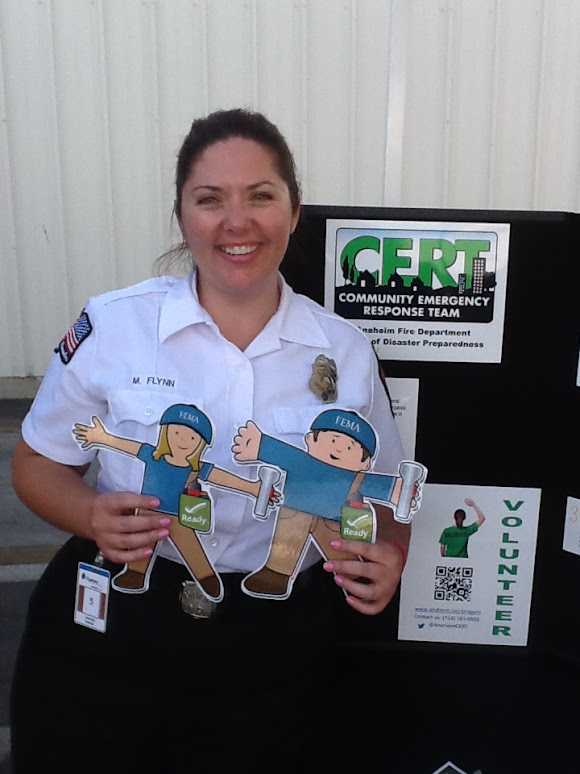
As the CERT class was getting ready to practice some of their skills, Fire Department volunteers spent some time with Flat Stanley and Stella reviewing fire safety, how to use a fire extinguisher and the importance of having a buddy with you.
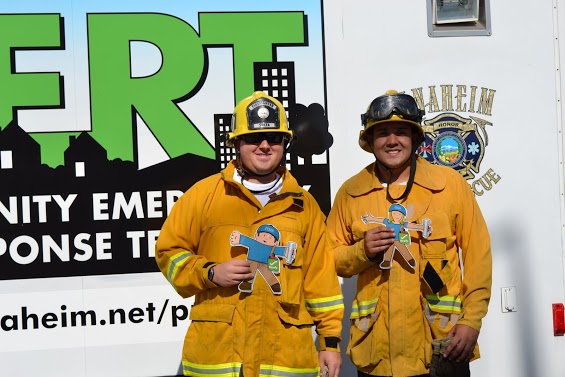
Flat Stanley and Stella also took a close look at an A-B-C fire extinguisher, which is one of the most common types of fire extinguishers to use for smaller fires.
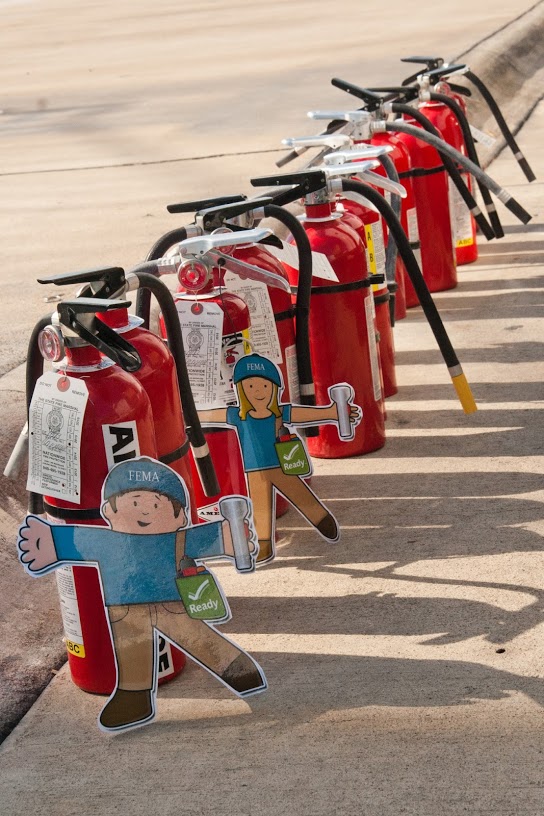
In addition to the CERT volunteers, Anaheim also has volunteers who specialize in radio communications who are members of Radio Amateur Civil Emergency Services (RACES) and were showing off their communications trailer and radio equipment to Flat Stanley and Stella.
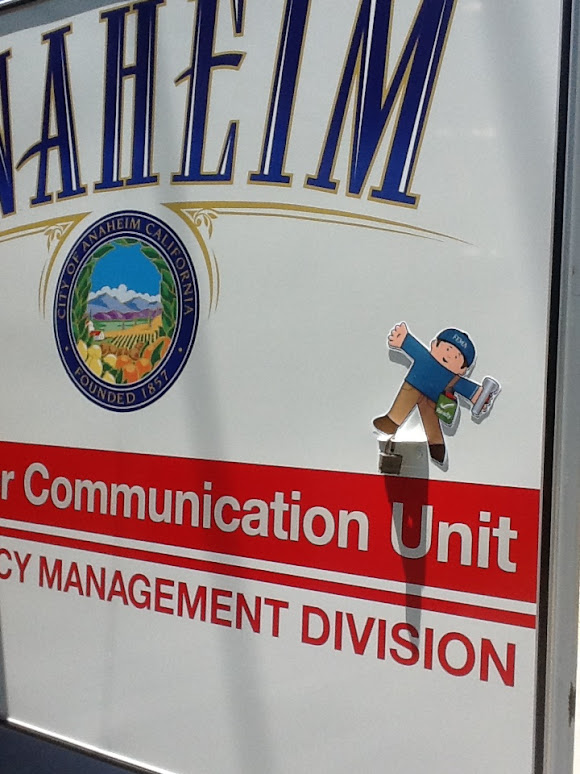
Finally, they were invited by CERT and RACES volunteer, Norman Todd, to get on the radio and practice sending messages. They learned that Norman and the RACES volunteers in Anaheim are part of a world-wide network of volunteers who have agreed to help first responders by relaying messages when other systems like telephone lines may not be working.
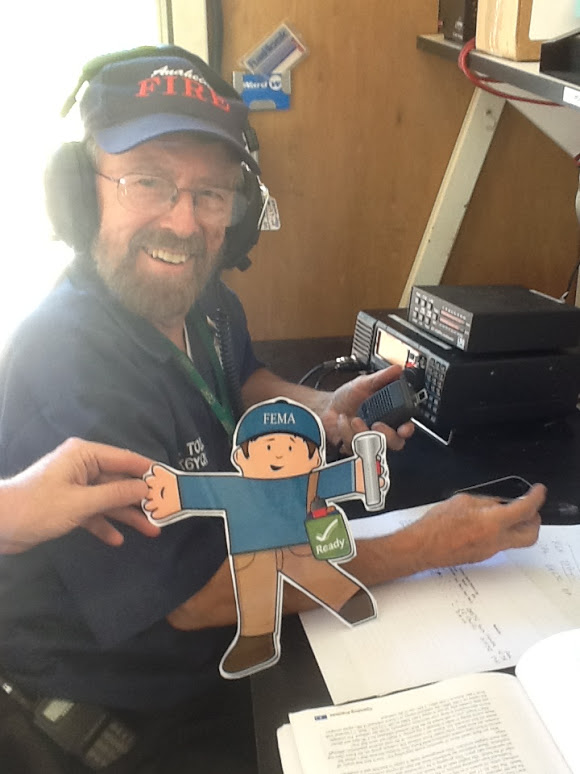
Before leaving to head back to Washington, D.C. we all stopped by the Anaheim Emergency Operations Center where they met RACES volunteer Jonathan Ramos who gave them a tour of the facility. They saw firsthand the value and importance each volunteer makes as part of Emergency Operations during disasters and how they are part of a much larger network of first responders from the local, regional, state and federal level.
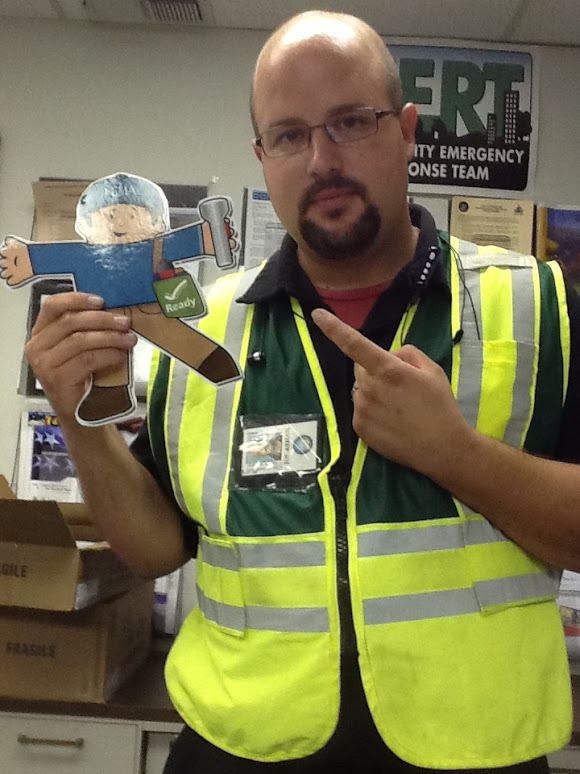
We look forward to future visits from FEMA Flat Stanley and Stella and we hope they are able to share with other communities the tremendous impact and difference volunteers make within a community.
The Anaheim Citizen Corps Program was honored to have FEMA Flat Stanley and Stella join us for a day of training in Anaheim, California. They were really excited to participate with our Community Emergency Response Team (CERT) and meet some of our residents and businesses in the area who wanted to be better prepared for disasters. They learned that the City of Los Angeles, Anaheim’s neighbor 30 miles to the north, started the CERT program after the 1985 Mexico City earthquake as a way for neighbors to help one another after emergencies. Anaheim has had a CERT program since 1992 and they are celebrating their 20th anniversary this November. FEMA Flat Stanley and Stella are certainly on the guest list!
Flat Stanley and Stella joined me in welcoming CERT students and encouraged them to become volunteers with the city once their training was complete.
As the CERT class was getting ready to practice some of their skills, Fire Department volunteers spent some time with Flat Stanley and Stella reviewing fire safety, how to use a fire extinguisher and the importance of having a buddy with you.
Flat Stanley and Stella also took a close look at an A-B-C fire extinguisher, which is one of the most common types of fire extinguishers to use for smaller fires.

In addition to the CERT volunteers, Anaheim also has volunteers who specialize in radio communications who are members of Radio Amateur Civil Emergency Services (RACES) and were showing off their communications trailer and radio equipment to Flat Stanley and Stella.
Finally, they were invited by CERT and RACES volunteer, Norman Todd, to get on the radio and practice sending messages. They learned that Norman and the RACES volunteers in Anaheim are part of a world-wide network of volunteers who have agreed to help first responders by relaying messages when other systems like telephone lines may not be working.
Before leaving to head back to Washington, D.C. we all stopped by the Anaheim Emergency Operations Center where they met RACES volunteer Jonathan Ramos who gave them a tour of the facility. They saw firsthand the value and importance each volunteer makes as part of Emergency Operations during disasters and how they are part of a much larger network of first responders from the local, regional, state and federal level.
We look forward to future visits from FEMA Flat Stanley and Stella and we hope they are able to share with other communities the tremendous impact and difference volunteers make within a community.
September 20, 2012
Being Prepared for the New School Year
Posted by: Flat Stanley and Flat Stella
Although we’ve only been working at FEMA for a few months now, we have learned how important it is to be prepared, no matter where you are. And with the new school year underway, we’ve been learning some important things to help keep kids and parents safer. Things like:
We hope everyone has a wonderful and safe school year! In case you missed any of our other adventures, check out our blog posts!
Although we’ve only been working at FEMA for a few months now, we have learned how important it is to be prepared, no matter where you are. And with the new school year underway, we’ve been learning some important things to help keep kids and parents safer. Things like:
And finally, parents should be sure to check with their children’s day care or school about what emergency plans they have. That way both parents and kids know what to expect during and after an emergency.
Complete an emergency contact card for each child in your family. Put the cards in their backpacks or book bags.
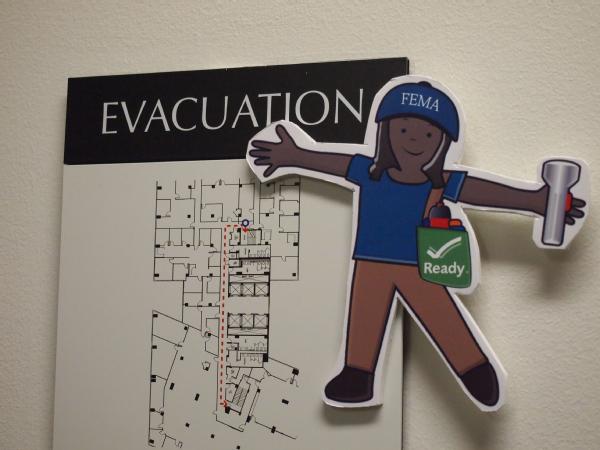
Find out how often they have students practice what to do in the event of severe weather or a fire.
Teach your children how and when to call 9-1-1 or your local emergency medical services number for help.

Ask your child's school for a copy of their emergency plan for you to keep at home or work.
We hope everyone has a wonderful and safe school year! In case you missed any of our other adventures, check out our blog posts!
September 14, 2012
What We're Watching: 9/14/12
Posted by: Lars Anderson, Director, Public Affairs
At the end of each week, we post a "What We’re Watching"
blog as we look ahead to the weekend and recap events from the week. We
encourage you to share it with your friends and family, and have a safe
weekend.
Weather outlook
As summer starts to fade into fall in some areas of the country, we continue to closely watch the tropics. As you know, we are currently at the peak of the Atlantic hurricane season, and the season continues until November 30. Currently, tropical storm Nadine is swirling in the Atlantic ocean and poses no threat to the U.S. or its territories. Keep up with the latest tropical forecast from the National Hurricane Center at www.hurricanes.gov or on your phone at http://hurricanes.gov/mobile.
And if you live in a coastal or inland area that could be affected by hurricanes or tropical storms, now's the time to prepare - visit www.Ready.gov/hurricanes or m.fema.gov on your phone to learn how.
Isaac recovery continues
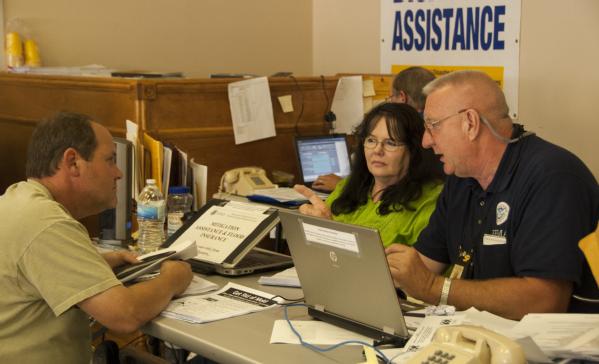
LaPlace, La., Sep. 11, 2012 – A FEMA Mitigation specialist talks to a Hurricane Isaac survivor in a Disaster Recovery Center. FEMA Mitigation specialists are assisting homeowners by providing them with information they need to rebuild their damaged property.
We continue to work closely with our state, local, and tribal partners as we assist those affected by Hurricane Isaac in Mississippi and Louisiana. Thousands have applied for disaster assistance so far, and Disaster Recovery Centers set up in the affected area continue to provide recovery information to disaster survivors. Earlier this week, we posted some stats about how Isaac survivors are applying for disaster assistance - I encourage you to check it out. The disaster pages for Louisiana and Mississippi have the latest information on FEMA's role in the recovery.
The excitement of graduation
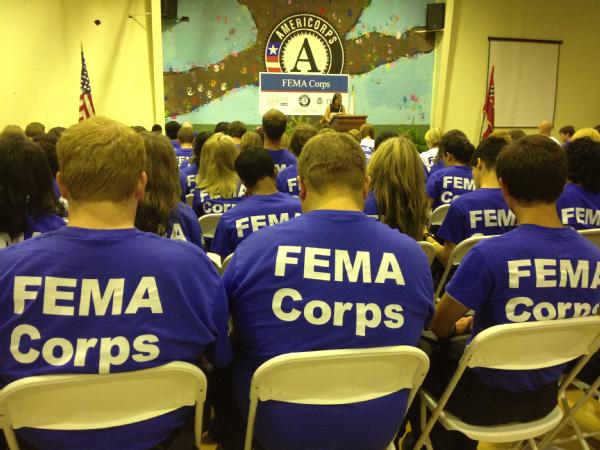
Vicksburg, Miss., Sep. 13, 2012 -- Induction Ceremony for the inaugural class of FEMA Corps members. FEMA Corps members assist with disaster preparedness, response, and recovery activities, providing support in areas ranging from working directly with disaster survivors to supporting disaster recovering centers to sharing valuable disaster preparedness and mitigation information with the public.
Lastly, all of us at FEMA are excited about the first class of FEMA Corps graduates that were newly minted earlier this week. FEMA Corps is a program that combines the expertise of FEMA and AmeriCorps to equip groups of young people to deploy into areas affected by disasters and assist the community with recovery. The new members, who range in age from 18-24 years old, will contribute to a dedicated, trained, and reliable disaster workforce by working full-time for ten months on federal disaster response and recovery efforts.
FEMA Deputy Administrator Rich Serino spoke to the class of 231 graduates yesterday, and he blogged about his perspective on the FEMA Corps program as well.
Have a great weekend!
Weather outlook
As summer starts to fade into fall in some areas of the country, we continue to closely watch the tropics. As you know, we are currently at the peak of the Atlantic hurricane season, and the season continues until November 30. Currently, tropical storm Nadine is swirling in the Atlantic ocean and poses no threat to the U.S. or its territories. Keep up with the latest tropical forecast from the National Hurricane Center at www.hurricanes.gov or on your phone at http://hurricanes.gov/mobile.
And if you live in a coastal or inland area that could be affected by hurricanes or tropical storms, now's the time to prepare - visit www.Ready.gov/hurricanes or m.fema.gov on your phone to learn how.
Isaac recovery continues

LaPlace, La., Sep. 11, 2012 – A FEMA Mitigation specialist talks to a Hurricane Isaac survivor in a Disaster Recovery Center. FEMA Mitigation specialists are assisting homeowners by providing them with information they need to rebuild their damaged property.
We continue to work closely with our state, local, and tribal partners as we assist those affected by Hurricane Isaac in Mississippi and Louisiana. Thousands have applied for disaster assistance so far, and Disaster Recovery Centers set up in the affected area continue to provide recovery information to disaster survivors. Earlier this week, we posted some stats about how Isaac survivors are applying for disaster assistance - I encourage you to check it out. The disaster pages for Louisiana and Mississippi have the latest information on FEMA's role in the recovery.
The excitement of graduation

Vicksburg, Miss., Sep. 13, 2012 -- Induction Ceremony for the inaugural class of FEMA Corps members. FEMA Corps members assist with disaster preparedness, response, and recovery activities, providing support in areas ranging from working directly with disaster survivors to supporting disaster recovering centers to sharing valuable disaster preparedness and mitigation information with the public.
Lastly, all of us at FEMA are excited about the first class of FEMA Corps graduates that were newly minted earlier this week. FEMA Corps is a program that combines the expertise of FEMA and AmeriCorps to equip groups of young people to deploy into areas affected by disasters and assist the community with recovery. The new members, who range in age from 18-24 years old, will contribute to a dedicated, trained, and reliable disaster workforce by working full-time for ten months on federal disaster response and recovery efforts.
FEMA Deputy Administrator Rich Serino spoke to the class of 231 graduates yesterday, and he blogged about his perspective on the FEMA Corps program as well.
Have a great weekend!
Learning How to Register for Disaster Assistance
Posted by: FEMA Flat Stanley & Flat Stella
Since
Hurricane Isaac, FEMA has been busy helping survivors get the help they
need. We learned that there are several places kids and their families
can visit if they need help or have questions. First, we visited a
Disaster Recovery Center in Louisiana.
A Disaster Recovery Center is where people can meet face to face with friendly FEMA staff. The people you meet at the center can teach people how they can get help after a disaster. So whether you are looking to learn who may be able to help fix your home or simply looking for information about how the recovery process works, we learned that a Disaster Recovery Center is a great place for people to visit. FEMA and other organizations are standing by ready to assist.

Even though we only visited one center, FEMA has set up many other Disaster Recovery Centers in both Louisiana and Mississippi. You can check out the Disaster Recovery Center Locator to find one near you!
If a survivor cannot visit a Disaster Recovery Center, we learned that there are three other ways to register for disaster assistance:
1. We visited www.disasterassistance.gov, where families can apply online:

2. We also downloaded the FEMA App, where people can apply on their smartphone:
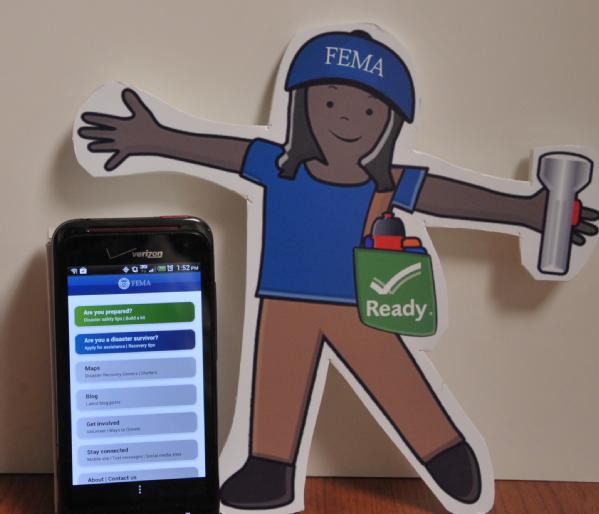
3. Finally, people can apply for assistance on the telephone by calling 1-800-621-FEMA.

It is not just FEMA helping disaster survivors - so many groups are working hard to provide survivors with the help they need. We hope you can help us spread the word about all the ways Hurricane Isaac survivors can apply for assistance!
A Disaster Recovery Center is where people can meet face to face with friendly FEMA staff. The people you meet at the center can teach people how they can get help after a disaster. So whether you are looking to learn who may be able to help fix your home or simply looking for information about how the recovery process works, we learned that a Disaster Recovery Center is a great place for people to visit. FEMA and other organizations are standing by ready to assist.

Even though we only visited one center, FEMA has set up many other Disaster Recovery Centers in both Louisiana and Mississippi. You can check out the Disaster Recovery Center Locator to find one near you!
If a survivor cannot visit a Disaster Recovery Center, we learned that there are three other ways to register for disaster assistance:
1. We visited www.disasterassistance.gov, where families can apply online:

2. We also downloaded the FEMA App, where people can apply on their smartphone:

3. Finally, people can apply for assistance on the telephone by calling 1-800-621-FEMA.

It is not just FEMA helping disaster survivors - so many groups are working hard to provide survivors with the help they need. We hope you can help us spread the word about all the ways Hurricane Isaac survivors can apply for assistance!
Update on Reservist Hiring Process
Posted by: Bob Fenton, Assistant Administrator, Response Directorate
More
than 7,000 welcome packets were mailed this week to our Disaster
Assistance Employees who successfully applied to become members of our
new Reservist Program. These packets contained each reservist’s
appointment letter assigning their position and cadre; and a “Conditions
of Employment” form that must be signed and returned by Sept. 23, 2012.
During the transition of our disaster workforce this summer, we implemented a three-level review process for all applicants. The process consisted of a preliminary review of applications to determine basic qualifications; applicants were then reviewed by recommendation panels with in-depth knowledge of the FQS job requirements by cadre; and final selection decisions by the selection panel.
This Phase 1 hiring process for the Reservist Program ensured that all DAEs who applied to the Reservist Program were offered a position within the limitations of force structure.
Each new member of the Reservist Program will be certified as either a “trainee” or a “qualified” employee within the cadre they are assigned. This was done to ensure that during future disaster deployments, a trainee can always be paired with more qualified employees so that adequate training and experience can be gained. This of course benefits the employee, as well as the disaster survivors and impacted communities as they begin their recovery process.
If an employee is deployed to a disaster area and unable to receive the welcome packet, they may contact the call center at 855-FQS-FEMA (377-3362) or send an email to FEMA-FQS-Program@fema.dhs.gov.
It is our hope that through this transition, we are better equipped to fulfill our mission to build, sustain and improve our capability to prepare for, protect against, respond to, and recover from and mitigate all hazards.
During the transition of our disaster workforce this summer, we implemented a three-level review process for all applicants. The process consisted of a preliminary review of applications to determine basic qualifications; applicants were then reviewed by recommendation panels with in-depth knowledge of the FQS job requirements by cadre; and final selection decisions by the selection panel.
This Phase 1 hiring process for the Reservist Program ensured that all DAEs who applied to the Reservist Program were offered a position within the limitations of force structure.
Each new member of the Reservist Program will be certified as either a “trainee” or a “qualified” employee within the cadre they are assigned. This was done to ensure that during future disaster deployments, a trainee can always be paired with more qualified employees so that adequate training and experience can be gained. This of course benefits the employee, as well as the disaster survivors and impacted communities as they begin their recovery process.
If an employee is deployed to a disaster area and unable to receive the welcome packet, they may contact the call center at 855-FQS-FEMA (377-3362) or send an email to FEMA-FQS-Program@fema.dhs.gov.
It is our hope that through this transition, we are better equipped to fulfill our mission to build, sustain and improve our capability to prepare for, protect against, respond to, and recover from and mitigate all hazards.
September 13, 2012
Welcome to the FEMA Corps Inaugural Class
Posted by: Rich Serino, Deputy Administrator
Today, we welcomed 231 energetic members into the first ever FEMA Corps class. The members just finished off their first month of training with our partners at the Corporation for National and Community Service (CNCS) and are one step closer to working in the field on disaster response and recovery. They will now head to FEMA’s Center for Domestic Preparedness to spend the next two weeks training in their FEMA position-specific roles. Once they complete both the CNCS and FEMA training, these 231 dedicated FEMA Corps members will be qualified to work in one of a variety of disaster related roles, ranging from Community Relations to Disaster Recovery Center support.

Vicksburg, Miss., Sep. 13, 2012 -- Deputy Administrator Rich Serino gives the keynote address at the Induction Ceremony for the inaugural class of FEMA Corps members. FEMA Corps members assist with disaster preparedness, response, and recovery activities, providing support in areas ranging from working directly with disaster survivors to supporting disaster recovering centers to sharing valuable disaster preparedness and mitigation information with the public.
FEMA Corps builds on the great work of AmeriCorps to establish a service cadre dedicated to disaster response and recover. To be sure, responding to disasters is nothing new for Americorps. In fact, the great work that AmeriCorps already does during disasters was the inspiration for FEMA Corps. When I visited communities all over the country that were devastated by disasters, from Joplin, MO to Bastrop, Texas, I always encountered the incredible members of AmeriCorps lending a helping hand to survivors. I was continually struck by the level of compassion, dedication, and skill these members brought to the table.
Today’s inductees are pioneers, combining the exceptional record of citizen service at AmeriCorps’ National Civilian Community Corps with FEMA’s specialized mission of supporting survivors with their recovery after a disaster. The new members, who range in age from 18-24 years old, will contribute to a dedicated, trained, and reliable disaster workforce by working full-time for ten months on federal disaster response and recovery efforts. As we announced in March, FEMA Corps sets the foundation for a new generation of emergency managers; it promotes civic engagement and offers an educational and financial opportunity for young people; and is designed to strengthen the nation’s disaster response by supplementing FEMA’s existing Reservist workforce.
I commend and thank every member of the inaugural class of FEMA Corps for their dedication to helping communities in need. Welcome to FEMA Corps!
To learn more about the new program, visit the AmeriCorps website or our FEMA Corps page.
Today, we welcomed 231 energetic members into the first ever FEMA Corps class. The members just finished off their first month of training with our partners at the Corporation for National and Community Service (CNCS) and are one step closer to working in the field on disaster response and recovery. They will now head to FEMA’s Center for Domestic Preparedness to spend the next two weeks training in their FEMA position-specific roles. Once they complete both the CNCS and FEMA training, these 231 dedicated FEMA Corps members will be qualified to work in one of a variety of disaster related roles, ranging from Community Relations to Disaster Recovery Center support.

Vicksburg, Miss., Sep. 13, 2012 -- Deputy Administrator Rich Serino gives the keynote address at the Induction Ceremony for the inaugural class of FEMA Corps members. FEMA Corps members assist with disaster preparedness, response, and recovery activities, providing support in areas ranging from working directly with disaster survivors to supporting disaster recovering centers to sharing valuable disaster preparedness and mitigation information with the public.
FEMA Corps builds on the great work of AmeriCorps to establish a service cadre dedicated to disaster response and recover. To be sure, responding to disasters is nothing new for Americorps. In fact, the great work that AmeriCorps already does during disasters was the inspiration for FEMA Corps. When I visited communities all over the country that were devastated by disasters, from Joplin, MO to Bastrop, Texas, I always encountered the incredible members of AmeriCorps lending a helping hand to survivors. I was continually struck by the level of compassion, dedication, and skill these members brought to the table.
Today’s inductees are pioneers, combining the exceptional record of citizen service at AmeriCorps’ National Civilian Community Corps with FEMA’s specialized mission of supporting survivors with their recovery after a disaster. The new members, who range in age from 18-24 years old, will contribute to a dedicated, trained, and reliable disaster workforce by working full-time for ten months on federal disaster response and recovery efforts. As we announced in March, FEMA Corps sets the foundation for a new generation of emergency managers; it promotes civic engagement and offers an educational and financial opportunity for young people; and is designed to strengthen the nation’s disaster response by supplementing FEMA’s existing Reservist workforce.
I commend and thank every member of the inaugural class of FEMA Corps for their dedication to helping communities in need. Welcome to FEMA Corps!
To learn more about the new program, visit the AmeriCorps website or our FEMA Corps page.
September 12, 2012
Training at the Center for Domestic Preparedness
Posted by: Lars Anderson, Director, Public Affairs
As we often say at FEMA, emergencies can strike at any moment, anywhere which is why it’s so important to be prepared for an emergency. The Center for Domestic Preparedness provides responders with knowledge to prevent, protect, respond to, and recover from chemical, biological, explosive, radiological, or other hazardous materials incidents. This training has proven to be a critical investment in ensuring responders, individuals, and communities are prepared for an emergency.
We wanted to share the recent experiences of Sutter Health employees that completed the Healthcare Leadership for Mass Casualty Incidents last month. Here's a quick recap from Robin Montgomery of Sutter Health on their training at the CDP:
The week-long emergency response training for natural disasters, terrorism and hazardous material accidents, covered a variety of disciplines including nursing, ancillary services, administration and support services. As with many of the classes at the CDP, the training combined classroom instruction, table-top discussions and exercises, followed with hands-on simulation drills.
Sutter Health spokesman Sy Neilson described his impression of the training, “they push your critical thinking abilities to the limit by overloading the system, withholding the resources you need and then watching how you respond. After the drills you discuss what worked well, what didn’t and what you plan to implement when you go back home. It’s a very worthwhile training for anyone who might respond to a disaster situation.”
Read more about this training at the CDP.
Visit the Center for Domestic Preparedness website for more information on available courses.
As we often say at FEMA, emergencies can strike at any moment, anywhere which is why it’s so important to be prepared for an emergency. The Center for Domestic Preparedness provides responders with knowledge to prevent, protect, respond to, and recover from chemical, biological, explosive, radiological, or other hazardous materials incidents. This training has proven to be a critical investment in ensuring responders, individuals, and communities are prepared for an emergency.
We wanted to share the recent experiences of Sutter Health employees that completed the Healthcare Leadership for Mass Casualty Incidents last month. Here's a quick recap from Robin Montgomery of Sutter Health on their training at the CDP:
The week-long emergency response training for natural disasters, terrorism and hazardous material accidents, covered a variety of disciplines including nursing, ancillary services, administration and support services. As with many of the classes at the CDP, the training combined classroom instruction, table-top discussions and exercises, followed with hands-on simulation drills.
Sutter Health spokesman Sy Neilson described his impression of the training, “they push your critical thinking abilities to the limit by overloading the system, withholding the resources you need and then watching how you respond. After the drills you discuss what worked well, what didn’t and what you plan to implement when you go back home. It’s a very worthwhile training for anyone who might respond to a disaster situation.”
Read more about this training at the CDP.
Visit the Center for Domestic Preparedness website for more information on available courses.
September 11, 2012
Isaac Survivors Go Mobile for Assistance
Posted by: Meddie Brown, Director, National Processing Service Centers Division
If anyone questions the value of smartphone devices, point them to Hurricane Isaac survivors. The disaster has helped us learn how survivors request and access assistance online during times of need. Fortunately, FEMA’s efforts prior to the storm, to put digital preparedness, response and recovery resources in the palms of peoples’ hands, have proven to be invaluable.
From August 31 to September 9, a record number of disaster survivors—primarily from Hurricane Isaac—used DisasterAssistance.gov to apply for assistance, update their information, and check the status of their application online. On September 4 alone, we received 55,752 visits to the site—the greatest volume of single-day traffic to the site since its launch in 2008, far surpassing the previous single-day high of 33,434 visitors from Tropical Storm Lee in September 2011. Also during this timeframe, 86,847 Hurricane Isaac survivors (combined total from web and mobile registrations) applied for assistance on DisasterAssistance.gov, 17,471 of whom applied using their smartphones. In addition, 57,480 status inquiries were made with the new mobile application inquiry feature, rolled-out in August, which gives survivors the ability to use their smartphones to check the status of their disaster assistance application.
DisasterAssistance.gov Hurricane Isaac Stats at a Glance: August 31 - September 9
The questionnaire serves as a tool to help survivors quickly and anonymously get a personalized list of possible assistance. Recently upgraded on both the full and mobile versions of DisasterAssistance.gov, the questionnaire is now dynamic, meaning it tailors recommendations based on how survivors answer questions as they answer them. More than 8,500 Isaac survivors have used the questionnaire, which also enables users to sort, tag, and find more information on specific forms of assistance, as well as to print and email their results.
The mobile outreach effort is part of a much larger, ongoing initiative to simplify the process of identifying and applying for disaster assistance for survivors using DisasterAssistance.gov as the first stop for disaster relief. A product of the Disaster Assistance Improvement Program, the website enables survivors to apply for FEMA Individual Assistance and refers them to other forms of assistance, like loan applications from the Small Business Administration. The site also provides community resource information and disaster news feeds to help individuals, families and businesses prepare for, respond to and recover from disasters.
DisasterAssistance.gov reduces the time needed to apply for aid and check the status of claims while decreasing redundancy in application forms and processes. For more information, visit www.DisasterAssistance.gov on your computer or m.fema.gov on your smartphone device.
If anyone questions the value of smartphone devices, point them to Hurricane Isaac survivors. The disaster has helped us learn how survivors request and access assistance online during times of need. Fortunately, FEMA’s efforts prior to the storm, to put digital preparedness, response and recovery resources in the palms of peoples’ hands, have proven to be invaluable.
From August 31 to September 9, a record number of disaster survivors—primarily from Hurricane Isaac—used DisasterAssistance.gov to apply for assistance, update their information, and check the status of their application online. On September 4 alone, we received 55,752 visits to the site—the greatest volume of single-day traffic to the site since its launch in 2008, far surpassing the previous single-day high of 33,434 visitors from Tropical Storm Lee in September 2011. Also during this timeframe, 86,847 Hurricane Isaac survivors (combined total from web and mobile registrations) applied for assistance on DisasterAssistance.gov, 17,471 of whom applied using their smartphones. In addition, 57,480 status inquiries were made with the new mobile application inquiry feature, rolled-out in August, which gives survivors the ability to use their smartphones to check the status of their disaster assistance application.
DisasterAssistance.gov Hurricane Isaac Stats at a Glance: August 31 - September 9
- 328,222 total web visits, 49,596 (18%) via a smartphone
- 86,847 total online applications submitted, 17,471 (20%) via a smartphone
- 160,637 total application inquiries, 57,480 (36%) via a smartphone
The questionnaire serves as a tool to help survivors quickly and anonymously get a personalized list of possible assistance. Recently upgraded on both the full and mobile versions of DisasterAssistance.gov, the questionnaire is now dynamic, meaning it tailors recommendations based on how survivors answer questions as they answer them. More than 8,500 Isaac survivors have used the questionnaire, which also enables users to sort, tag, and find more information on specific forms of assistance, as well as to print and email their results.
The mobile outreach effort is part of a much larger, ongoing initiative to simplify the process of identifying and applying for disaster assistance for survivors using DisasterAssistance.gov as the first stop for disaster relief. A product of the Disaster Assistance Improvement Program, the website enables survivors to apply for FEMA Individual Assistance and refers them to other forms of assistance, like loan applications from the Small Business Administration. The site also provides community resource information and disaster news feeds to help individuals, families and businesses prepare for, respond to and recover from disasters.
DisasterAssistance.gov reduces the time needed to apply for aid and check the status of claims while decreasing redundancy in application forms and processes. For more information, visit www.DisasterAssistance.gov on your computer or m.fema.gov on your smartphone device.
How We Prepared for Isaac
Posted by: Craig Fugate, Administrator
It’s been three weeks since Tropical Depression #9 became “Isaac” in the central Atlantic. Over that time, we saw a slowly growing and changing storm and a closely coordinated emergency management team that was ready to respond to it. The team included local, state, tribal and federal government, the private sector, faith-based organizations and volunteer agencies– and FEMA was proud to be part of it.
I traveled across the Gulf Coast, before, during and after the storm, and witnessed years of advanced planning become a smart response. Investments in mitigation paid off, preventing the storm from being more destructive. Emergency managers didn’t wait for the storm to hit, and FEMA worked with state and local authorities to prepare and get supplies in place. Finally, we had an eye on recovery before the storm arrived, which aided communities in accelerating the recovery process. The bottom line – everyone worked together to prepare for this storm and it saved lives.
Isaac was initially a threat to Puerto Rico and the U.S. Virgin Islands, where FEMA deployed Incident Management Assessment Teams to assist local officials and prepare to distribute federal resources that are staged year-round in the Caribbean. As the storm passed to the south of the islands, residents experienced some flash flooding, but thankfully avoided a direct hit from the storm.
As the storm proceeded towards Florida, I was on the ground in my home state to ensure that the federal government was in full support of local efforts. With an unclear path for the storm, officials from the east coast of Florida through the Gulf Coast started preparing for Isaac. FEMA staged resources in Jacksonville, Florida and Montgomery, Alabama, ready to move them closer to the impacted region as the path became clearer. While the storm was still in the Gulf of Mexico, I traveled along the I-10 highway, visiting with the governors and/or emergency managers in Florida, Alabama, Mississippi and Louisiana as the storm approached.
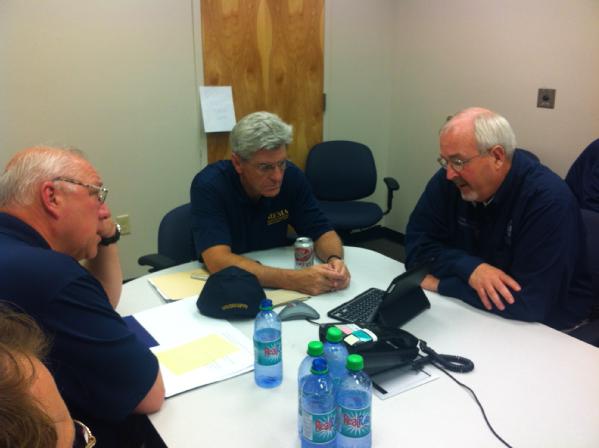
Gulfport, Miss., Aug. 28, 2012 -- FEMA Administrator Craig Fugate meeting with MEMA Director Robert Latham (left) and Mississippi Gov. Bryant (center) to discuss Hurricane Isaac preparations.
We made sure we were working closely together before the storm made landfall and on Tuesday, President Obama signed emergency declarations for Louisiana and Mississippi in advance of the onset of the storm, making aid available for federal support to save lives and to protect property, public health and safety in designated counties and parishes. First responders could get to work knowing that the federal government had their back.
I’ve waited for a lot of storms to make landfall and the anticipation never gets easier. The close coordination the federal government had with the states beforehand left me more confident than ever that our team was prepared.
The preparedness measures were in the making longer than two weeks— they went back years. Smart investments in mitigation projects protected people and property across the impacted region. On average, every $1 invested in mitigation saves $4 that would have been expended on a disaster. After hurricanes Katrina and Rita, FEMA’s Hazard Mitigation Grant Program provided grants to communities and state agencies for projects designed to save lives and protect property.
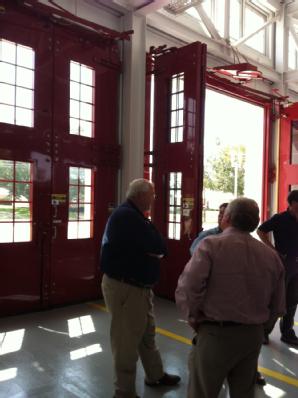
Bay St. Louis, Miss., Sep. 4, 2012 -- FEMA Administrator Craig Fugate visits the Bay St. Louis Fire Department in Mississippi following Hurricane Isaac.
In Mississippi, I visited the Bay St. Louis Fire House which was heavily impacted by Hurricane Katrina in 2005. In August, 2010, the community cut the ribbon on a new Fire House that doubles as a safe room for up to 68 first responders, protecting them from winds in excess of 200 miles per hours for a period of 36 hours. When Hurricane Isaac made landfall, slowly drenching the Gulf Coast in rain, first responders were able to respond and save lives because they had prepared.
In Louisiana, the Plaquemines Parish Faculty Housing project opened just last month, replacing housing destroyed by Hurricane Katrina. This time, the new housing was elevated to protect it from flooding. With the support of FEMA, the Plaquemines Parish School Board also rebuilt many of its schools over the last few years, following Hurricanes Katrina, Rita, Gustav and Ike. Reports from the school board indicate that damage from Hurricane Isaac is minimal and none of the facilities flooded, thanks to smart investments in mitigation. As a result, all Plaquemines Parish schools were open yesterday, helping kids in the community to move beyond the storm.

Plaquemines Parish, La., Aug. 6, 2012 -- Photo of the Plaquemines Parish Faculty Housing project which celebrated its opening on August 6, 2012. FEMA obligated $8 million to this project which replaced housing destroyed by Hurricane Katrina. The project was elevated to comply with the new Digital Flood Insurance Rate Map elevation for the area, which is in south Plaquemines Parish. FEMA has obligated a total of $206 million to the Plaquemines Parish School Board to rebuild its schools following Hurricanes Katrina, Rita, Gustav and Ike.
Inevitably after a disaster, the national spotlight moves on to something else, but FEMA isn’t going anywhere. This is a team effort and we are on the Gulf Coast to assist the local authorities and support the recovery effort. Also supporting that effort are dozens of voluntary agencies. Their work is far reaching and has a real impact on Isaac survivors. If you are interested in a way to help, visit the National VOAD website at www.nvoad.org. An individual’s support goes a long way to aiding affected communities recover.
It’s been three weeks since Tropical Depression #9 became “Isaac” in the central Atlantic. Over that time, we saw a slowly growing and changing storm and a closely coordinated emergency management team that was ready to respond to it. The team included local, state, tribal and federal government, the private sector, faith-based organizations and volunteer agencies– and FEMA was proud to be part of it.
I traveled across the Gulf Coast, before, during and after the storm, and witnessed years of advanced planning become a smart response. Investments in mitigation paid off, preventing the storm from being more destructive. Emergency managers didn’t wait for the storm to hit, and FEMA worked with state and local authorities to prepare and get supplies in place. Finally, we had an eye on recovery before the storm arrived, which aided communities in accelerating the recovery process. The bottom line – everyone worked together to prepare for this storm and it saved lives.
Isaac was initially a threat to Puerto Rico and the U.S. Virgin Islands, where FEMA deployed Incident Management Assessment Teams to assist local officials and prepare to distribute federal resources that are staged year-round in the Caribbean. As the storm passed to the south of the islands, residents experienced some flash flooding, but thankfully avoided a direct hit from the storm.
As the storm proceeded towards Florida, I was on the ground in my home state to ensure that the federal government was in full support of local efforts. With an unclear path for the storm, officials from the east coast of Florida through the Gulf Coast started preparing for Isaac. FEMA staged resources in Jacksonville, Florida and Montgomery, Alabama, ready to move them closer to the impacted region as the path became clearer. While the storm was still in the Gulf of Mexico, I traveled along the I-10 highway, visiting with the governors and/or emergency managers in Florida, Alabama, Mississippi and Louisiana as the storm approached.

Gulfport, Miss., Aug. 28, 2012 -- FEMA Administrator Craig Fugate meeting with MEMA Director Robert Latham (left) and Mississippi Gov. Bryant (center) to discuss Hurricane Isaac preparations.
We made sure we were working closely together before the storm made landfall and on Tuesday, President Obama signed emergency declarations for Louisiana and Mississippi in advance of the onset of the storm, making aid available for federal support to save lives and to protect property, public health and safety in designated counties and parishes. First responders could get to work knowing that the federal government had their back.
I’ve waited for a lot of storms to make landfall and the anticipation never gets easier. The close coordination the federal government had with the states beforehand left me more confident than ever that our team was prepared.
The preparedness measures were in the making longer than two weeks— they went back years. Smart investments in mitigation projects protected people and property across the impacted region. On average, every $1 invested in mitigation saves $4 that would have been expended on a disaster. After hurricanes Katrina and Rita, FEMA’s Hazard Mitigation Grant Program provided grants to communities and state agencies for projects designed to save lives and protect property.

Bay St. Louis, Miss., Sep. 4, 2012 -- FEMA Administrator Craig Fugate visits the Bay St. Louis Fire Department in Mississippi following Hurricane Isaac.
In Mississippi, I visited the Bay St. Louis Fire House which was heavily impacted by Hurricane Katrina in 2005. In August, 2010, the community cut the ribbon on a new Fire House that doubles as a safe room for up to 68 first responders, protecting them from winds in excess of 200 miles per hours for a period of 36 hours. When Hurricane Isaac made landfall, slowly drenching the Gulf Coast in rain, first responders were able to respond and save lives because they had prepared.
In Louisiana, the Plaquemines Parish Faculty Housing project opened just last month, replacing housing destroyed by Hurricane Katrina. This time, the new housing was elevated to protect it from flooding. With the support of FEMA, the Plaquemines Parish School Board also rebuilt many of its schools over the last few years, following Hurricanes Katrina, Rita, Gustav and Ike. Reports from the school board indicate that damage from Hurricane Isaac is minimal and none of the facilities flooded, thanks to smart investments in mitigation. As a result, all Plaquemines Parish schools were open yesterday, helping kids in the community to move beyond the storm.

Plaquemines Parish, La., Aug. 6, 2012 -- Photo of the Plaquemines Parish Faculty Housing project which celebrated its opening on August 6, 2012. FEMA obligated $8 million to this project which replaced housing destroyed by Hurricane Katrina. The project was elevated to comply with the new Digital Flood Insurance Rate Map elevation for the area, which is in south Plaquemines Parish. FEMA has obligated a total of $206 million to the Plaquemines Parish School Board to rebuild its schools following Hurricanes Katrina, Rita, Gustav and Ike.
Inevitably after a disaster, the national spotlight moves on to something else, but FEMA isn’t going anywhere. This is a team effort and we are on the Gulf Coast to assist the local authorities and support the recovery effort. Also supporting that effort are dozens of voluntary agencies. Their work is far reaching and has a real impact on Isaac survivors. If you are interested in a way to help, visit the National VOAD website at www.nvoad.org. An individual’s support goes a long way to aiding affected communities recover.
Categories |
Hurricanes,
Preparedness,
Severe Tropical Weather
September 7, 2012
Hurricane Preparedness and Continued Recovery Efforts in the Gulf Coast
Posted by: Lars Anderson, Director, Public Affairs
September is National Preparedness Month, and FEMA is encouraging individuals, organizations, and communities to promote emergency preparedness by taking the Pledge to Prepare for natural disasters. Now is the perfect time for those living in coastal states, as well as inland areas to consider the hazards that hurricanes and tropical storms bring, making areas vulnerable to risks such as flooding, high winds, tornadoes and storm surge.
According to the National Hurricane Center, August through October are the peak months for the Atlantic hurricane season, which continues until November 30. It is important to take steps now to be prepared to ensure that your family and property are safe. Visit Ready.gov or Listo.gov for more information. As of today, there are two hurricanes located in the central Atlantic Ocean, and although these storms are not forecast to pose any threat to the United States mainland or its territories, there is a probability additional storms may form later during the remainder of hurricane season. Earlier this hurricane season, Tropical Storm Debby affected parts of Florida, and most recently Hurricane Isaac impacted parts of the Gulf Coast. FEMA continues to work with federal, state, local and tribal officials to coordinate the ongoing response and recovery efforts in affected states.
In Louisiana and Mississippi, more than 150,000 Louisiana and Mississippi residents have applied for federal assistance, and more than $28 million has been approved for housing assistance and other needs. Assistance can include grants for temporary housing and home repairs, uninsured property losses, and other programs to help individuals and households recover from the effects of the disaster. More than 1,900 housing inspectors are visiting neighborhoods to assess damages. More than 40,000 inspections have been completed. Disaster survivors in Louisiana and Mississippi in need of assistance should visit www.disasterassistance.gov for more information on the assistance available in their area. Survivors without access to the internet can call 1-800-621-3362, and survivors who have a speech disability or hearing loss and use TTY should call 1-800-462-7585 directly; those who use 711 or Video Relay Service (VRS) should call 1-800-621-3362.
Disaster recovery centers are open in many disaster affected areas in Louisiana and Mississippi. These centers are the place for disaster survivors to meet one-on-one with officials from voluntary and non-profit agencies, local communities, and state and federal agencies such as FEMA and the Small Business Administration to learn more about the various types of assistance available to disaster survivors. More information about disaster recovery centers is available at www.fema.gov/disaster-recovery-centers or by mobile phone at m.fema.gov.
National Voluntary Organizations Active in Disaster (National VOAD) members including voluntary, non-profit and faith-based organizations also are working closely with the affected states and communities to assist with debris removal and supporting with temporary roofing for disaster survivors.
Joint federal, state and local disaster assessments continue in Louisiana and Mississippi. These assessments identify the damages in impacted counties to help the governor determine if additional federal support will be requested. We encourage you to visit the disaster-specific web pages for Mississippi and Louisiana at fema.gov for more information.
Hurricane Isaac and Tropical Storm Debby serve as important reminders that natural disasters can happen anytime and anywhere. By taking steps now to prepare for emergencies, you can ensure that your family and community are prepared to respond and recover from all types of potential disasters and hazards. We encourage everyone to make the pledge to prepare this month and help themselves, their neighbors and their communities be Ready. You can start by visiting www.Ready.gov/today and download a family emergency plan, emergency kit checklists, and additional information on how to get involved locally. Together, our efforts will build a stronger and more resilient nation.
You can keep up to date on the latest tropical systems in the Atlantic and Pacific by visiting www.hurricanes.gov or hurricanes.gov/mobile on your phone.
Recent Updates on the Isaac Recovery:
September is National Preparedness Month, and FEMA is encouraging individuals, organizations, and communities to promote emergency preparedness by taking the Pledge to Prepare for natural disasters. Now is the perfect time for those living in coastal states, as well as inland areas to consider the hazards that hurricanes and tropical storms bring, making areas vulnerable to risks such as flooding, high winds, tornadoes and storm surge.
According to the National Hurricane Center, August through October are the peak months for the Atlantic hurricane season, which continues until November 30. It is important to take steps now to be prepared to ensure that your family and property are safe. Visit Ready.gov or Listo.gov for more information. As of today, there are two hurricanes located in the central Atlantic Ocean, and although these storms are not forecast to pose any threat to the United States mainland or its territories, there is a probability additional storms may form later during the remainder of hurricane season. Earlier this hurricane season, Tropical Storm Debby affected parts of Florida, and most recently Hurricane Isaac impacted parts of the Gulf Coast. FEMA continues to work with federal, state, local and tribal officials to coordinate the ongoing response and recovery efforts in affected states.
In Louisiana and Mississippi, more than 150,000 Louisiana and Mississippi residents have applied for federal assistance, and more than $28 million has been approved for housing assistance and other needs. Assistance can include grants for temporary housing and home repairs, uninsured property losses, and other programs to help individuals and households recover from the effects of the disaster. More than 1,900 housing inspectors are visiting neighborhoods to assess damages. More than 40,000 inspections have been completed. Disaster survivors in Louisiana and Mississippi in need of assistance should visit www.disasterassistance.gov for more information on the assistance available in their area. Survivors without access to the internet can call 1-800-621-3362, and survivors who have a speech disability or hearing loss and use TTY should call 1-800-462-7585 directly; those who use 711 or Video Relay Service (VRS) should call 1-800-621-3362.
Disaster recovery centers are open in many disaster affected areas in Louisiana and Mississippi. These centers are the place for disaster survivors to meet one-on-one with officials from voluntary and non-profit agencies, local communities, and state and federal agencies such as FEMA and the Small Business Administration to learn more about the various types of assistance available to disaster survivors. More information about disaster recovery centers is available at www.fema.gov/disaster-recovery-centers or by mobile phone at m.fema.gov.
National Voluntary Organizations Active in Disaster (National VOAD) members including voluntary, non-profit and faith-based organizations also are working closely with the affected states and communities to assist with debris removal and supporting with temporary roofing for disaster survivors.
Joint federal, state and local disaster assessments continue in Louisiana and Mississippi. These assessments identify the damages in impacted counties to help the governor determine if additional federal support will be requested. We encourage you to visit the disaster-specific web pages for Mississippi and Louisiana at fema.gov for more information.
Hurricane Isaac and Tropical Storm Debby serve as important reminders that natural disasters can happen anytime and anywhere. By taking steps now to prepare for emergencies, you can ensure that your family and community are prepared to respond and recover from all types of potential disasters and hazards. We encourage everyone to make the pledge to prepare this month and help themselves, their neighbors and their communities be Ready. You can start by visiting www.Ready.gov/today and download a family emergency plan, emergency kit checklists, and additional information on how to get involved locally. Together, our efforts will build a stronger and more resilient nation.
You can keep up to date on the latest tropical systems in the Atlantic and Pacific by visiting www.hurricanes.gov or hurricanes.gov/mobile on your phone.
Recent Updates on the Isaac Recovery:
- Thursday, Sept. 6, FEMA amended the Major Disaster Declaration for Hurricane Isaac for Louisiana, making Individual Assistance available in five additional Louisiana parishes — Assumption, St. Helena, St. James, Terrebonne and Washington. Individuals in areas in Louisiana and Mississippi that have been designated for individual assistance can apply for assistance by registering online at www.disasterassistance.gov on a web enabled mobile device at m.fema.gov. Disaster survivors who not have access to the Internet can call 1-800-621-FEMA (3362). Survivors who have a speech disability or hearing loss and use TTY may call 1-800-462-7585. Individuals who use 711 or Video Relay Service (VRS) may call 1-800-621-3362. The toll-free telephone numbers operate from 7 a.m. to 10 p.m. (local time) seven days a week until further notice. Assistance can include grants for temporary housing, home repairs, rental assistance, uninsured property losses, and other programs that help individuals and households recover from the effects of the disaster. Federal disaster assistance will not duplicate insurance benefits, but may provide for uncovered losses.
- FEMA, in coordination with the state of Louisiana launched the Transitional Sheltering Assistance program for Hurricane Isaac evacuees. This program allows eligible evacuees to stay in hotels or motels if their homes are inaccessible or unlivable due to the disaster. The initiative is designed to provide temporary lodging for eligible disaster survivors who have a continuing need for shelter after the congregate shelters have closed. The state has prioritized those with the most critical needs for emergency lodging in hotels and motels, especially the elderly and those with illnesses exacerbated by the heat who are staying in shelters. Registering with FEMA is the first step to potential federal disaster assistance, including the Transitional Sheltering Assistance program.
- FEMA Disaster Recovery Center (DRCs) have opened in disaster affected areas of Louisiana and Mississippi. At these centers, disaster survivors can meet one-on-one with officials from voluntary and non-profit agencies, local communities, the state, and federal agencies such as FEMA and the Small Business Administration to learn more about the various types of assistance available to disaster survivors. To find a disaster recovery center location, go to www.fema.gov/disaster-recovery-centers or by mobile phone at m.fema.gov.
- U.S. Environmental Protection Agency, in coordination with the Department of Energy and as per the requests of the states affected by Hurricane Isaac has exercised its authority under the Clean Air Act to temporarily waive certain federal clean gasoline requirements for gasoline sold and distributed in Louisiana, Mississippi, Alabama, Georgia, Florida, Tennessee, South Carolina and North Carolina. The disruption and delays in production and delivery of gasoline resulted from effects of Hurricane Isaac. The federal waiver will help ensure an adequate supply of gasoline in the impacted states until normal supply to the region can be restored.
- U.S. Corps of Engineers (USACE) continues to work with state and federal partners to ensure a coordinated federal response to Isaac. USACE reported the status at the Pearl River Lock is stable. At the time of potential failure and threat of flooding, the lock was under caretaker status and not actively operated or maintained by the federal government. USACE is operating the Greater New Orleans District Hurricane and Storm Damage Risk Reduction System (HSDRRS), and all major structures are now open.
- U.S. Department of Transportation Federal Highway Administration announced $3.5 million in quick Release Emergency Relief Funds for Hurricane Isaac Damage in Louisiana. The announcement builds up on the major disaster declaration approved by President Barack Obama. The Federal Highway Administration (FHWA) will be used to pay for debris removal and the repair of traffic signals and signs, highway shoulders and movable bridges.
- U.S. Department of Treasury Internal Revenue Service provided tax relief to individuals and business affected by Hurricane Isaac. Affected tax payers in Louisiana (Ascension, Jefferson, Lafourche, Livingston, Orleans, Plaquemines, St. Bernard, St. Charles, St. John The Baptist, St. Tammany parishes and Mississippi (Hancock, Harrison, Jackson and Pearl counties) will receive tax relief that postpones tax filling and payment deadlines that occurred on or after August 26, 2012. As a result, affected individuals and business will have until January 11, 2012 to file returns and pay any taxes due. The tax relief includes corporations and business that received similar extension until October 15, 2012. More details are available on www.irs.gov/uac/Tax-Relief-in-Disaster-Situations.
- Tuesday, Sept. 4, FEMA granted the state of Louisiana’s request to designate St. Charles Parish for Individual Assistance, opening the way for state and federal assistance to eligible homeowners, renters and business owners affected by Hurricane Isaac.
What We’re Watching: 9/7/12
Posted by: Lars Anderson, Director, Public Affairs
At the end of each week, we post a "What We’re Watching" blog as we look ahead to the weekend and recap events from the week. We encourage you to share it with your friends and family, and have a safe weekend.
Weather Outlook
Our partners at the National Weather Service continue to monitor tropical weather activity, specifically a low pressure system that is producing overcast and some rain along the Gulf Coast. Although this system has a low chance of becoming a tropical cyclone, we will also continue to monitor weather conditions.
We are also monitoring Tropical Storm Leslie and Hurricane Michael in the Atlantic, although both of these storms are not expected to impact the U.S at this time.
Stay up to date with the latest forecast from the NOAA National Hurricane Center at hurricanes.gov or on your phone at hurricanes.gov/mobile. For updates on the local weather in your area, visit weather.gov or m.weather.gov on your phone.
Hurricane Isaac Photo Recap
As we continue our recovery efforts following the aftermath of Hurricane Isaac, we wanted to share some photos from the past couple of days highlighting the great work being done by federal, state, tribal, and local government agencies, community and faith-based organizations, non-profit organizations, and the private sector to assist survivors as they recover from the storm.
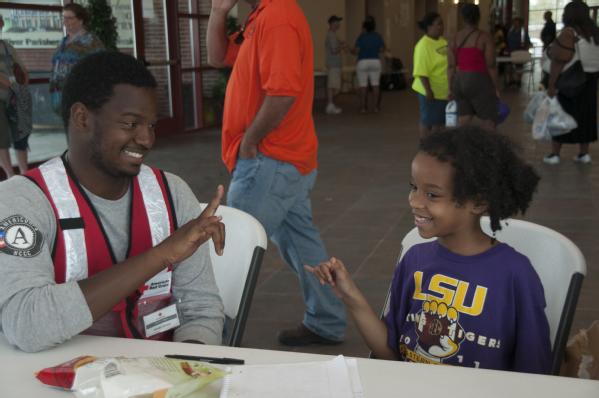
LaPlace, La., Sep. 5, 2012 -- Jamaal Johnson, an AmeriCorp volunteer teaches a child sign language at the St. John's Baptist Community Center where a temporary shelter has been set up for Hurricane Isaac survivors. FEMA is working with local, state and federal agencies to provide services for residents affected by Hurricane Isaac.
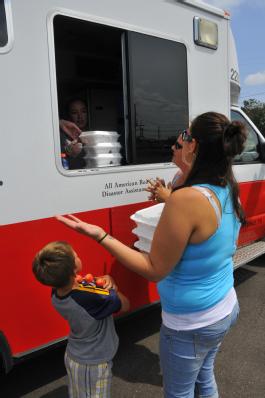
LaPlace, La., Sep. 5, 2012 -- A family of Hurricane Isaac survivors from LaPlace, La. grab a meal from the Red Cross at a distribution center. This group of volunteers came from Houston to help those affected by Hurricane Isaac.
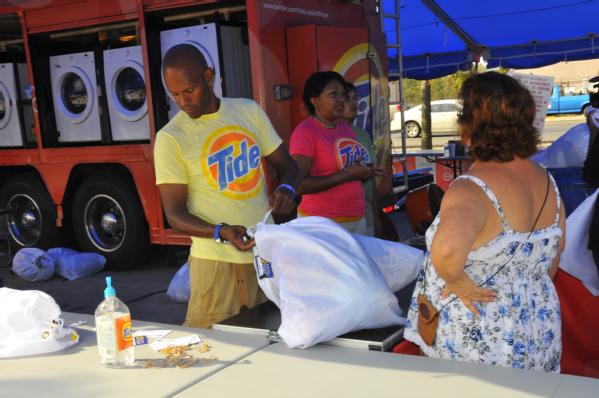 LaPlace, La., Sep. 4, 2012 -- Roger Bostic, left, and Raynell Parker McNeil bag laundry for washing, drying, and folding for a family affected by Hurricane Isaac. Hundreds in LaPlace, La affected by Hurricane Isaac have taken advantage of the service provided by Tide at no charge.
LaPlace, La., Sep. 4, 2012 -- Roger Bostic, left, and Raynell Parker McNeil bag laundry for washing, drying, and folding for a family affected by Hurricane Isaac. Hundreds in LaPlace, La affected by Hurricane Isaac have taken advantage of the service provided by Tide at no charge.
 Pascagoula, Miss., Sep. 5, 2012 -- A survivor of Hurricane Isaac completes the application for disaster assistance with a representative of the Small Business Administration. Disaster Recovery Centers have all the representatives of state and federal agencies to assist applicants.
Pascagoula, Miss., Sep. 5, 2012 -- A survivor of Hurricane Isaac completes the application for disaster assistance with a representative of the Small Business Administration. Disaster Recovery Centers have all the representatives of state and federal agencies to assist applicants.
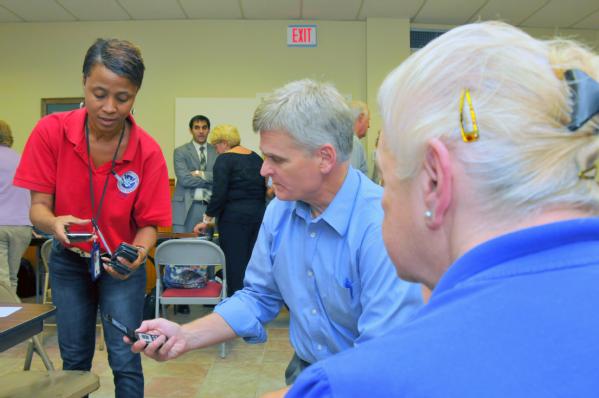
French Settlement, La., Sep. 5, 2012 -- Applicant Services Specialists, Teia Beaulieu, left, and U.S. Congressman Bill Cassidy, M.D., Sixth District of Louisiana, compare signal strength on their cell phone while helping a woman affect by Hurricane Isaac call to register for assistance. Congressman Cassidy requested that FEMA representatives attend the town hall meeting in French Settlement, La. to take questions and provided information to the community.
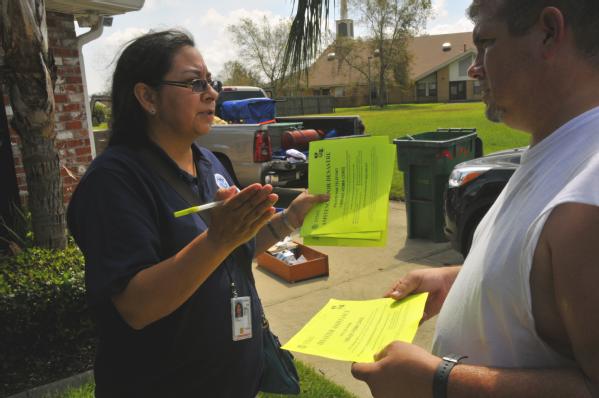
La Place, La., Sep. 3, 2012 -- Community Relations Specialist, Patricia "Alley" West, (left) goes door to door in neighborhoods affected by Hurricane Isaac handing out flyers and providing information to assist residents who may qualify for FEMA assistance. Areas in La Place flooded when the slow moving storm passed through.

Orleans Parish, La., Sep. 3, 2012 -- Volunteers are working to remove debris from neighborhoods which impacted by during Hurricane Isaac movement through the area.
For more information on how you can assist survivors of Hurricane Isaac, visit www.fema.gov/volunteer-donate-responsibly.
National Preparedness Month
We are officially one week into National Preparedness Month -- but it’s not too late to pledge to prepare and take the necessary steps to get yourself, family, friends, coworkers, and community prepared for an emergency. The goal of National Preparedness Month is to encourage individuals, businesses, government agencies, and nonprofit organizations to learn about the local hazards in your community, make a family communication plan, build an emergency kit, then get involved in your local community preparedness efforts.
The first step to getting involved in National Preparedness Month is registering as a coalition member at Ready.gov/pledge. There you will join a community of thousands of individuals, emergency management professionals, businesses, and voluntary and faith-based groups, sharing emergency preparedness information and events, resources, and tools available to help get you prepared for an emergency and spreading preparedness in your own community.
We hope that you will join us and help promote a culture of preparedness by becoming a coalition member and pledging to prepare this September for NPM.
Have a great weekend!
At the end of each week, we post a "What We’re Watching" blog as we look ahead to the weekend and recap events from the week. We encourage you to share it with your friends and family, and have a safe weekend.
Weather Outlook
Our partners at the National Weather Service continue to monitor tropical weather activity, specifically a low pressure system that is producing overcast and some rain along the Gulf Coast. Although this system has a low chance of becoming a tropical cyclone, we will also continue to monitor weather conditions.
We are also monitoring Tropical Storm Leslie and Hurricane Michael in the Atlantic, although both of these storms are not expected to impact the U.S at this time.
Stay up to date with the latest forecast from the NOAA National Hurricane Center at hurricanes.gov or on your phone at hurricanes.gov/mobile. For updates on the local weather in your area, visit weather.gov or m.weather.gov on your phone.
Hurricane Isaac Photo Recap
As we continue our recovery efforts following the aftermath of Hurricane Isaac, we wanted to share some photos from the past couple of days highlighting the great work being done by federal, state, tribal, and local government agencies, community and faith-based organizations, non-profit organizations, and the private sector to assist survivors as they recover from the storm.

LaPlace, La., Sep. 5, 2012 -- Jamaal Johnson, an AmeriCorp volunteer teaches a child sign language at the St. John's Baptist Community Center where a temporary shelter has been set up for Hurricane Isaac survivors. FEMA is working with local, state and federal agencies to provide services for residents affected by Hurricane Isaac.

LaPlace, La., Sep. 5, 2012 -- A family of Hurricane Isaac survivors from LaPlace, La. grab a meal from the Red Cross at a distribution center. This group of volunteers came from Houston to help those affected by Hurricane Isaac.
 LaPlace, La., Sep. 4, 2012 -- Roger Bostic, left, and Raynell Parker McNeil bag laundry for washing, drying, and folding for a family affected by Hurricane Isaac. Hundreds in LaPlace, La affected by Hurricane Isaac have taken advantage of the service provided by Tide at no charge.
LaPlace, La., Sep. 4, 2012 -- Roger Bostic, left, and Raynell Parker McNeil bag laundry for washing, drying, and folding for a family affected by Hurricane Isaac. Hundreds in LaPlace, La affected by Hurricane Isaac have taken advantage of the service provided by Tide at no charge.
 Pascagoula, Miss., Sep. 5, 2012 -- A survivor of Hurricane Isaac completes the application for disaster assistance with a representative of the Small Business Administration. Disaster Recovery Centers have all the representatives of state and federal agencies to assist applicants.
Pascagoula, Miss., Sep. 5, 2012 -- A survivor of Hurricane Isaac completes the application for disaster assistance with a representative of the Small Business Administration. Disaster Recovery Centers have all the representatives of state and federal agencies to assist applicants.

French Settlement, La., Sep. 5, 2012 -- Applicant Services Specialists, Teia Beaulieu, left, and U.S. Congressman Bill Cassidy, M.D., Sixth District of Louisiana, compare signal strength on their cell phone while helping a woman affect by Hurricane Isaac call to register for assistance. Congressman Cassidy requested that FEMA representatives attend the town hall meeting in French Settlement, La. to take questions and provided information to the community.

La Place, La., Sep. 3, 2012 -- Community Relations Specialist, Patricia "Alley" West, (left) goes door to door in neighborhoods affected by Hurricane Isaac handing out flyers and providing information to assist residents who may qualify for FEMA assistance. Areas in La Place flooded when the slow moving storm passed through.

Orleans Parish, La., Sep. 3, 2012 -- Volunteers are working to remove debris from neighborhoods which impacted by during Hurricane Isaac movement through the area.
For more information on how you can assist survivors of Hurricane Isaac, visit www.fema.gov/volunteer-donate-responsibly.
National Preparedness Month
We are officially one week into National Preparedness Month -- but it’s not too late to pledge to prepare and take the necessary steps to get yourself, family, friends, coworkers, and community prepared for an emergency. The goal of National Preparedness Month is to encourage individuals, businesses, government agencies, and nonprofit organizations to learn about the local hazards in your community, make a family communication plan, build an emergency kit, then get involved in your local community preparedness efforts.
The first step to getting involved in National Preparedness Month is registering as a coalition member at Ready.gov/pledge. There you will join a community of thousands of individuals, emergency management professionals, businesses, and voluntary and faith-based groups, sharing emergency preparedness information and events, resources, and tools available to help get you prepared for an emergency and spreading preparedness in your own community.
We hope that you will join us and help promote a culture of preparedness by becoming a coalition member and pledging to prepare this September for NPM.
Have a great weekend!
Serving people with disabilities during and after Isaac
Posted by: Marcie Roth, Director, Office of Disability and Integration Coordination
Even before Tropical Storm Isaac hit the Gulf coast, FEMA disability integration specialists from across the nation were preparing to travel to the areas that would be hardest hit. There, they would join other FEMA personnel and countless others from voluntary and community organizations, local, state and federal government, and the private sector who would answer the call to help the survivors of Isaac’s lingering and widespread deluge of rain and wind.
Right now, FEMA has seven Disability Integration Advisors serving in Louisiana and Mississippi. Their expertise is guiding the actions of the officials who lead FEMA’s response in areas hardest hit by Isaac. They are experts in disability inclusive emergency management who use their knowledge to prevent, address or solve problems for individuals with access and functional needs and their communities.
Our Disability Integration Advisors work with state and local government officials to coordinate and advise on issues such as:
Often, advisors have the opportunity to talk with disaster survivors and help them firsthand. Linda Landers, one of our Disability Integration Specialists, is working in Louisiana where she recently helped a mother and her adult son who has a spinal cord injury. After several days without power, they were forced to make a decision to shelter in place or travel from Jefferson Parish to a shelter in Baton Rouge. When the family decided to shelter in place, Linda made sure that local emergency responders and emergency management were aware of their decision and knew how to contact them. Throughout the night and next day, Linda checked in with them to be sure they were not in danger. The power has since been restored and all are doing well.
Ongoing support for recovery
As FEMA and the states began setting up Disaster Recovery Centers, FEMA disability integration advisors assessed conditions to determine potential issues, such as physical accessibility so people using wheelchairs can easily enter a building or area. They also looked for equipment that ensures effective communication by people who have low vision or are blind and others who are hard of hearing or deaf when filing assistance claims in Disaster Recovery Centers. Here’s an example of some of the equipment that is available at a center:
FEMA’s Disability Integration Advisors will continue to ensure those with access and functional needs have equal access to the assistance and services available after Isaac. Visit our webpage to learn more.
Even before Tropical Storm Isaac hit the Gulf coast, FEMA disability integration specialists from across the nation were preparing to travel to the areas that would be hardest hit. There, they would join other FEMA personnel and countless others from voluntary and community organizations, local, state and federal government, and the private sector who would answer the call to help the survivors of Isaac’s lingering and widespread deluge of rain and wind.
Right now, FEMA has seven Disability Integration Advisors serving in Louisiana and Mississippi. Their expertise is guiding the actions of the officials who lead FEMA’s response in areas hardest hit by Isaac. They are experts in disability inclusive emergency management who use their knowledge to prevent, address or solve problems for individuals with access and functional needs and their communities.
Our Disability Integration Advisors work with state and local government officials to coordinate and advise on issues such as:
- The availability of accessible transportation,
- Evacuations from nursing homes, group homes, assisted living facilities, and people served under state programs, such as mental health and developmental disability programs,
- Access to prescription medication,
- Access to medical, personal assistance services and durable medical equipment in shelters.
Often, advisors have the opportunity to talk with disaster survivors and help them firsthand. Linda Landers, one of our Disability Integration Specialists, is working in Louisiana where she recently helped a mother and her adult son who has a spinal cord injury. After several days without power, they were forced to make a decision to shelter in place or travel from Jefferson Parish to a shelter in Baton Rouge. When the family decided to shelter in place, Linda made sure that local emergency responders and emergency management were aware of their decision and knew how to contact them. Throughout the night and next day, Linda checked in with them to be sure they were not in danger. The power has since been restored and all are doing well.
Ongoing support for recovery
As FEMA and the states began setting up Disaster Recovery Centers, FEMA disability integration advisors assessed conditions to determine potential issues, such as physical accessibility so people using wheelchairs can easily enter a building or area. They also looked for equipment that ensures effective communication by people who have low vision or are blind and others who are hard of hearing or deaf when filing assistance claims in Disaster Recovery Centers. Here’s an example of some of the equipment that is available at a center:
FEMA’s Disability Integration Advisors will continue to ensure those with access and functional needs have equal access to the assistance and services available after Isaac. Visit our webpage to learn more.
Categories |
Hurricanes,
Preparedness,
Strengthening the team
September 6, 2012
Our visit to the American Red Cross
Posted by: FEMA Flat Stanley & Stella
Even
though Hurricane Isaac is gone, there is a lot of work to do! We’ve
been here at FEMA watching all the activity that happens after a
disaster to get families back on their feet. A lot of people in
Louisiana and Mississippi need help, and we have learned that it takes teamwork to get them what they need!
FEMA isn’t the only group working to help survivors. There are a lot of volunteers helping families who have been impacted by Hurricane Isaac. Volunteers are people who help others for free, because they want to make a difference. FEMA works with many groups of people who volunteer their time, services, and supplies during disasters. There have been so many of these helping hands after the hurricane!
One of FEMA’s partners that relies on volunteers to get the job done is the American Red Cross. Today, we stopped by the Red Cross to see what they are doing to help people after Hurricane Isaac.
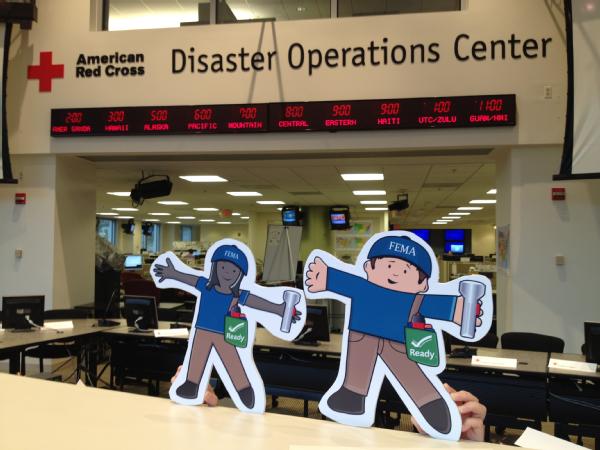
The Red Cross provides meals, supplies, and shelter to people during and after a disaster. A shelter is a place where families can stay if their homes are in harm’s way or damaged during a disaster.
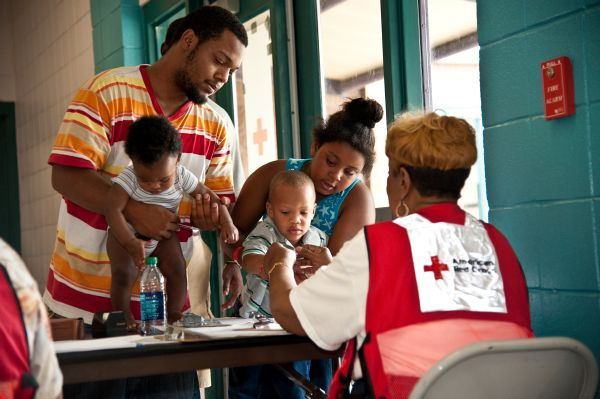
The Red Cross also provides useful things to people after a disaster, like these:
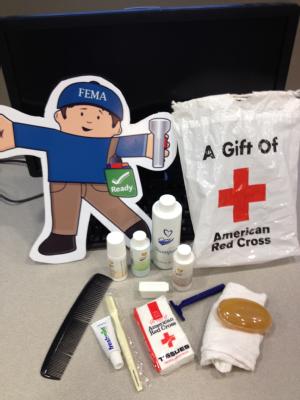
That’s called a “comfort kit”. It is given out so people can have important things they need, like a toothbrush, comb for your hair, tissues, and a bar of soap. While visiting the Red Cross, we also learned they have trucks that carry food and supplies to the disaster area.

Here is a map showing where some of the Red Cross trucks are located across the country:
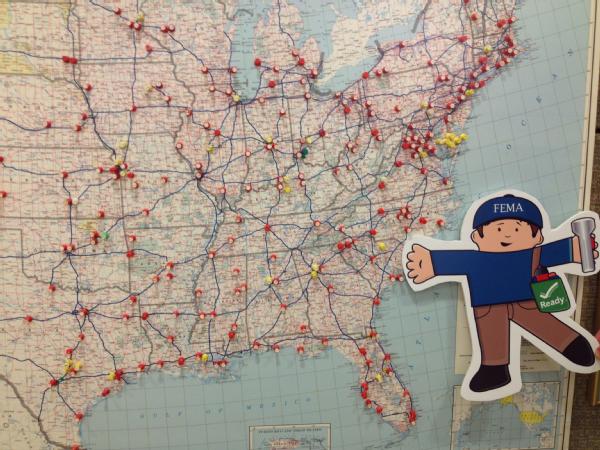
There are lots of ways for everyone to get involved and help survivors of Hurricane Isaac. You can be a volunteer or raise money to give to volunteer groups (like the American Red Cross and other groups that do important work after disasters).
If you are interested in helping, you and your family can visit the National Voluntary Organizations Active in Disaster website at www.nvoad.org. We were so happy to learn about the work of one of FEMA’s partners that relies on volunteers, and we hope to visit more soon! The work of these groups goes a long way to help families and communities recover from disasters.
----------
Editor’s note: We are providing the following examples for your reference. FEMA does not endorse any non-government organizations, companies or applications.
FEMA isn’t the only group working to help survivors. There are a lot of volunteers helping families who have been impacted by Hurricane Isaac. Volunteers are people who help others for free, because they want to make a difference. FEMA works with many groups of people who volunteer their time, services, and supplies during disasters. There have been so many of these helping hands after the hurricane!
One of FEMA’s partners that relies on volunteers to get the job done is the American Red Cross. Today, we stopped by the Red Cross to see what they are doing to help people after Hurricane Isaac.

The Red Cross provides meals, supplies, and shelter to people during and after a disaster. A shelter is a place where families can stay if their homes are in harm’s way or damaged during a disaster.

The Red Cross also provides useful things to people after a disaster, like these:

That’s called a “comfort kit”. It is given out so people can have important things they need, like a toothbrush, comb for your hair, tissues, and a bar of soap. While visiting the Red Cross, we also learned they have trucks that carry food and supplies to the disaster area.

Here is a map showing where some of the Red Cross trucks are located across the country:

There are lots of ways for everyone to get involved and help survivors of Hurricane Isaac. You can be a volunteer or raise money to give to volunteer groups (like the American Red Cross and other groups that do important work after disasters).
If you are interested in helping, you and your family can visit the National Voluntary Organizations Active in Disaster website at www.nvoad.org. We were so happy to learn about the work of one of FEMA’s partners that relies on volunteers, and we hope to visit more soon! The work of these groups goes a long way to help families and communities recover from disasters.
----------
Editor’s note: We are providing the following examples for your reference. FEMA does not endorse any non-government organizations, companies or applications.
September 5, 2012
Helping People & Pets After Isaac: Non-profit partners at work
Posted by: Lars Anderson, Director, Public Affairs
We often say that FEMA is one part of the team that helps Americans prepare, respond, and recover from disasters. Over the past few weeks, this has been very evident in the response and recovery to Hurricane Isaac around the Gulf Coast. In addition to the tireless work of our federal, state, local, and tribal government partners, the support of countless non-profit and voluntary organizations has been vital in providing assistance to survivors of Isaac.
Below are three stories that demonstrate the work of a few of our non-profit partners: the Humane Society, the Salvation Army, and the American Red Cross. To learn more about their work and other organizations like them, visit the National Voluntary Organizations Active in Disasters website.
A quick message from our lawyers: We are providing the following examples for your reference. FEMA does not endorse any non-government organizations, companies or applications. The views expressed below do not necessarily represent the official views of the United States, the Department of Homeland Security, or the Federal Emergency Management Agency.
Hurricane Isaac hit the Gulf Coast last week–almost seven years to the day that Katrina struck that same area. Isaac’s heavy rains brought severe flooding in inland areas, and high winds and storm surges overtopped some levees, such as in Plaquemines Parish. Many people were forced to evacuate from their homes, and tens of thousands lost power.

Frank Loftus/The HSUS
One of 200 dogs and cats that The HSUS transported.
The HSUS kept a close eye on Hurricane Isaac before it made landfall--encouraging residents to take their pets with them if evacuating, providing information through social media about pet-friendly shelters, evacuation routes, and other animal-related resources, and staying in touch with emergency management officials about the needs of affected communities.
In the years since Hurricane Katrina, the enactment of a federal pets and disaster bill (the Pet Evacuation and Transportation Safety Act) and public education campaigns by The HSUS and other groups have brought important progress in preparedness and achieved a broad change in consciousness how about pets and the human-animal bond are accounted for in disasters. Last week, a video news report from WWL-TV in Louisiana commented on the changes since Katrina as they showed rescuers saving a man and his four dogs trapped by severe flooding from Isaac.
When our Animal Rescue Team received a call from Jefferson Parish, La., we deployed to assist animals at risk. We worked with Jefferson Parish Animal Shelter to help care for pets separated from their families as well as stray animals. PetSmart Charities also assisted by donating pet food and supplies. And over Labor Day weekend, our team transported more than 160 homeless pets from the shelter to our Emergency Placement Partners in several states. The Humane Society of Charlotte, N.C., also generously provided its facility as a central location for other placement partners to pick up Isaac animals from our transport. The HSUS is transporting more than 60 additional pets to Maryland where we're providing emergency care for them until they can be adopted.
In Mississippi, we worked with McComb Animal Control officers and local volunteers to rescue more than 20 horses from flood waters that would have soon overtaken the animals, and we joined with the Okaloosa County Disaster Animal Response Team to transport homeless pets from the McComb Animal Shelter to the Montgomery Humane Society in Alabama. Transports like these ease the burden on local shelters affected by disasters and give these animals a better chance of finding loving homes.
-----------------------------------------------------
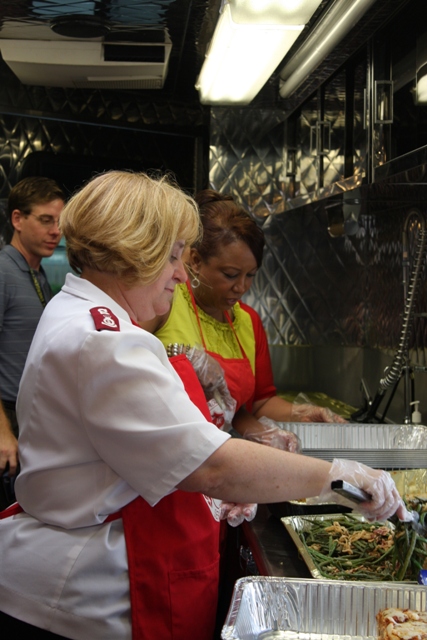
Thanks to the generosity and prayers of our supporters – such as BP, AmeriCares, local businesses, and donors from across the country – we are continuing to provide shelter, food, hydration, and emotional and spiritual care to residents in the Gulf Coast following Tropical Storm Isaac’s arrival almost one week ago.
Thus far, volunteers and personnel of The Salvation Army have provided almost 35,000 meals and 42,000 drinks via the 25 mobile feeding units and field kitchen serving in the hardest-hit areas of Louisiana, Alabama, Mississippi and Florida.
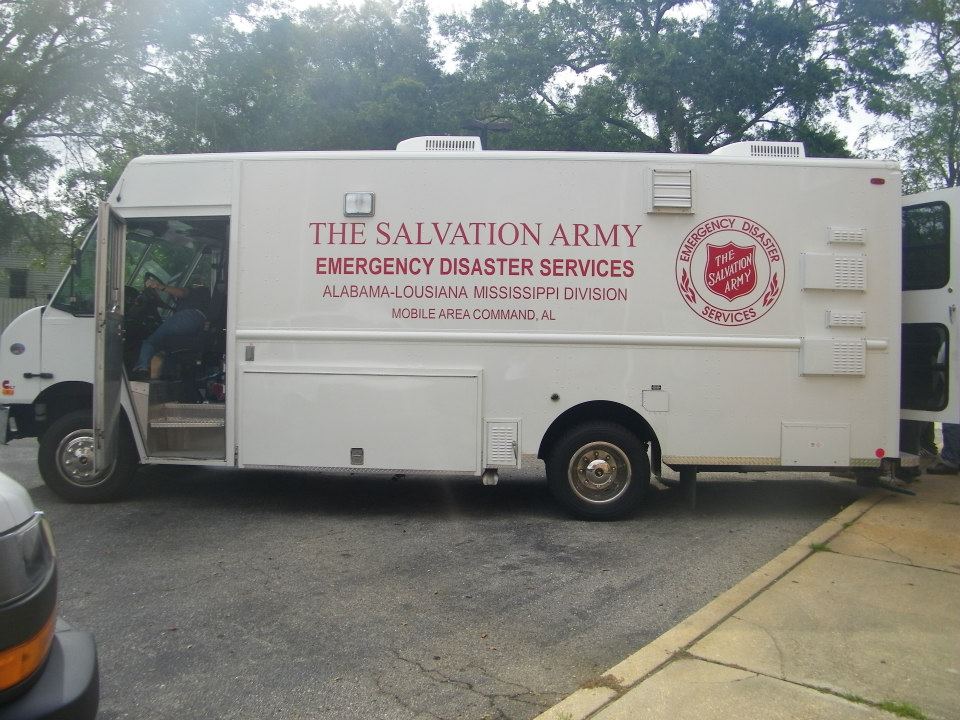
Specifically, mobile kitchens and Salvation Army personnel have been deployed to New Orleans and Slidell, LA; Pass Christian and Hancock County, MS among other locations. For a list of canteens and shelters currently open and serving, please visit our Emergency Disaster Services page by clicking here.
Our relief efforts always involve an element of counseling, with the understanding that natural disasters such as this can be emotionally traumatizing to those impacted, specifically to Gulf Coast residents remembering Hurricane Katrina from 2005.
Throughout this last week, The Salvation Army has been providing emotional and spiritual support with 900 individuals receiving care so far.

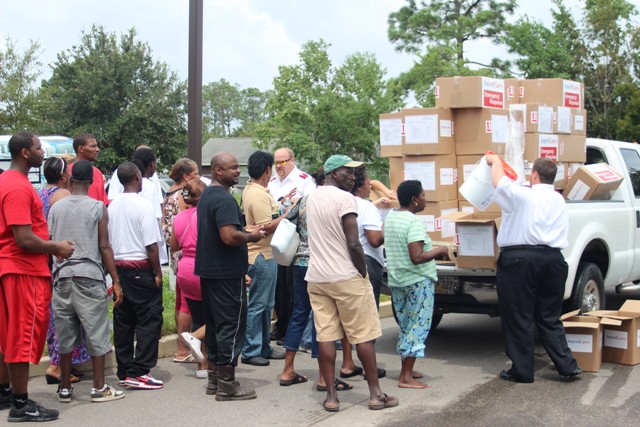
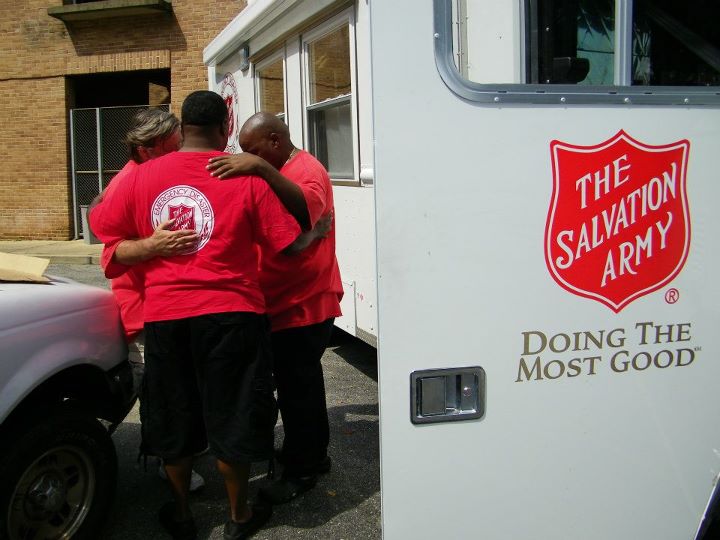
The Salvation Army is prepared to continue serving families and individuals in the recovery process going forward so long as we are needed. Ranging from shelter and food to material requests or clean-up kits, we strive to meet the unique needs of storm survivors through your support. Because each person’s needs are different, monetary donations are the most efficient and effective way to support our disaster relief efforts.
For the last week, every single time I turned on the evening news I came face-to-face with stories about and images related to Hurricane Isaac. In the days leading up to the storm’s arrival, coverage focused on weather predictions and evacuation plans. After Isaac made landfall, coverage transitioned to updates on rainfall totals, wind speeds, and the status of the levy and pump systems. As soon as the worst of the weather had passed, newscasters spoke of the rescues, as well as the hundreds of thousands without power and the unknown number without shelter, food, clothing, and medicine.
For the last week, every single time I turned on the evening news I came face-to-face with stories about and images of American Red Cross volunteers. In the days leading up to the storm’s arrival, volunteers were preparing to transport supplies and travel to the Gulf Coast. After Isaac made landfall, volunteers were setting up and staffing shelters, providing basic necessities to those who had fled their homes with no more than the clothes on their backs. As soon as the worst of the weather had passed, volunteers were in the field, assessing storm damage and providing water, food, and comfort kits to those who’d stayed behind.
Every single time I turned on the television, American Red Cross volunteers were there, generously giving their time, sharing their skills, and offering what those who just lived through this traumatic event needed most: shelter, water, food, clothing, medicine…and hope.
So today I simply want to say thank you. To the American Red Cross volunteers who answer the call, and leave behind their own lives – their families, friends, jobs, and homes – for weeks at a time, to lift up fellow human beings in their time of need.
Thank you.

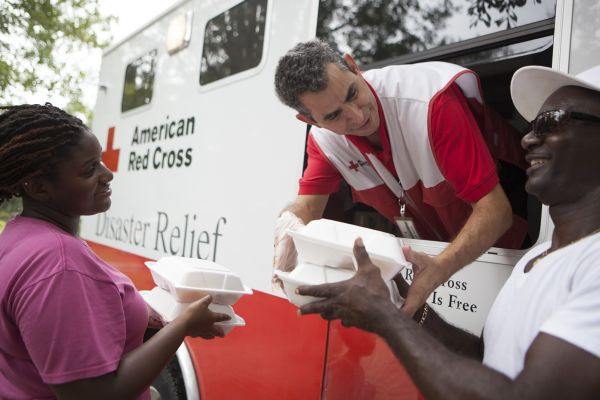
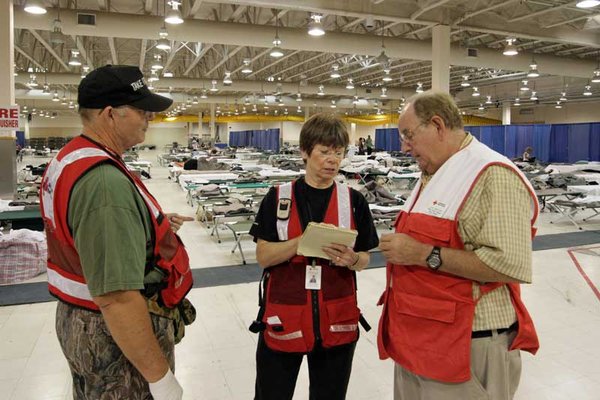
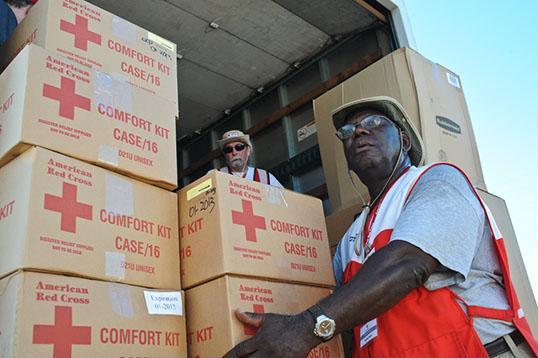

We often say that FEMA is one part of the team that helps Americans prepare, respond, and recover from disasters. Over the past few weeks, this has been very evident in the response and recovery to Hurricane Isaac around the Gulf Coast. In addition to the tireless work of our federal, state, local, and tribal government partners, the support of countless non-profit and voluntary organizations has been vital in providing assistance to survivors of Isaac.
Below are three stories that demonstrate the work of a few of our non-profit partners: the Humane Society, the Salvation Army, and the American Red Cross. To learn more about their work and other organizations like them, visit the National Voluntary Organizations Active in Disasters website.
A quick message from our lawyers: We are providing the following examples for your reference. FEMA does not endorse any non-government organizations, companies or applications. The views expressed below do not necessarily represent the official views of the United States, the Department of Homeland Security, or the Federal Emergency Management Agency.
Humane Society: Pets Weather the Storm of Hurricane Isaac
Posted September 4Hurricane Isaac hit the Gulf Coast last week–almost seven years to the day that Katrina struck that same area. Isaac’s heavy rains brought severe flooding in inland areas, and high winds and storm surges overtopped some levees, such as in Plaquemines Parish. Many people were forced to evacuate from their homes, and tens of thousands lost power.
Frank Loftus/The HSUS
One of 200 dogs and cats that The HSUS transported.
The HSUS kept a close eye on Hurricane Isaac before it made landfall--encouraging residents to take their pets with them if evacuating, providing information through social media about pet-friendly shelters, evacuation routes, and other animal-related resources, and staying in touch with emergency management officials about the needs of affected communities.
In the years since Hurricane Katrina, the enactment of a federal pets and disaster bill (the Pet Evacuation and Transportation Safety Act) and public education campaigns by The HSUS and other groups have brought important progress in preparedness and achieved a broad change in consciousness how about pets and the human-animal bond are accounted for in disasters. Last week, a video news report from WWL-TV in Louisiana commented on the changes since Katrina as they showed rescuers saving a man and his four dogs trapped by severe flooding from Isaac.
When our Animal Rescue Team received a call from Jefferson Parish, La., we deployed to assist animals at risk. We worked with Jefferson Parish Animal Shelter to help care for pets separated from their families as well as stray animals. PetSmart Charities also assisted by donating pet food and supplies. And over Labor Day weekend, our team transported more than 160 homeless pets from the shelter to our Emergency Placement Partners in several states. The Humane Society of Charlotte, N.C., also generously provided its facility as a central location for other placement partners to pick up Isaac animals from our transport. The HSUS is transporting more than 60 additional pets to Maryland where we're providing emergency care for them until they can be adopted.
In Mississippi, we worked with McComb Animal Control officers and local volunteers to rescue more than 20 horses from flood waters that would have soon overtaken the animals, and we joined with the Okaloosa County Disaster Animal Response Team to transport homeless pets from the McComb Animal Shelter to the Montgomery Humane Society in Alabama. Transports like these ease the burden on local shelters affected by disasters and give these animals a better chance of finding loving homes.
-----------------------------------------------------
Salvation Army: Mobile Kitchens Deployed to New Orleans & Slidell, LA
Posted by Megan, Salvation Army on Monday, September 3, 2012
Thanks to the generosity and prayers of our supporters – such as BP, AmeriCares, local businesses, and donors from across the country – we are continuing to provide shelter, food, hydration, and emotional and spiritual care to residents in the Gulf Coast following Tropical Storm Isaac’s arrival almost one week ago.
Thus far, volunteers and personnel of The Salvation Army have provided almost 35,000 meals and 42,000 drinks via the 25 mobile feeding units and field kitchen serving in the hardest-hit areas of Louisiana, Alabama, Mississippi and Florida.

Specifically, mobile kitchens and Salvation Army personnel have been deployed to New Orleans and Slidell, LA; Pass Christian and Hancock County, MS among other locations. For a list of canteens and shelters currently open and serving, please visit our Emergency Disaster Services page by clicking here.
Our relief efforts always involve an element of counseling, with the understanding that natural disasters such as this can be emotionally traumatizing to those impacted, specifically to Gulf Coast residents remembering Hurricane Katrina from 2005.
Throughout this last week, The Salvation Army has been providing emotional and spiritual support with 900 individuals receiving care so far.



The Salvation Army is prepared to continue serving families and individuals in the recovery process going forward so long as we are needed. Ranging from shelter and food to material requests or clean-up kits, we strive to meet the unique needs of storm survivors through your support. Because each person’s needs are different, monetary donations are the most efficient and effective way to support our disaster relief efforts.
American Red Cross: Thank You
Posted on September 4, 2012 by Erin Ferris, American Red CrossFor the last week, every single time I turned on the evening news I came face-to-face with stories about and images related to Hurricane Isaac. In the days leading up to the storm’s arrival, coverage focused on weather predictions and evacuation plans. After Isaac made landfall, coverage transitioned to updates on rainfall totals, wind speeds, and the status of the levy and pump systems. As soon as the worst of the weather had passed, newscasters spoke of the rescues, as well as the hundreds of thousands without power and the unknown number without shelter, food, clothing, and medicine.
For the last week, every single time I turned on the evening news I came face-to-face with stories about and images of American Red Cross volunteers. In the days leading up to the storm’s arrival, volunteers were preparing to transport supplies and travel to the Gulf Coast. After Isaac made landfall, volunteers were setting up and staffing shelters, providing basic necessities to those who had fled their homes with no more than the clothes on their backs. As soon as the worst of the weather had passed, volunteers were in the field, assessing storm damage and providing water, food, and comfort kits to those who’d stayed behind.
Every single time I turned on the television, American Red Cross volunteers were there, generously giving their time, sharing their skills, and offering what those who just lived through this traumatic event needed most: shelter, water, food, clothing, medicine…and hope.
So today I simply want to say thank you. To the American Red Cross volunteers who answer the call, and leave behind their own lives – their families, friends, jobs, and homes – for weeks at a time, to lift up fellow human beings in their time of need.
Thank you.





September 3, 2012
Isaac update 10: September 3 recap
Posted by Lars Anderson, Public Affairs
Today, President Barack Obama met with state and local officials in Louisiana and viewed ongoing response and recovery efforts to Hurricane Isaac.
Secretary of Homeland Security Janet Napolitano traveled to Mississippi and Louisiana on Sunday to visit areas damaged by the storm. Also, Administrator Craig Fugate has been in the impacted region since before the storm made landfall. In Louisiana and Mississippi, he has been traveling and meeting with disaster survivors, state and local officials and FEMA staff.
National Voluntary Organizations Active in Disaster (National VOAD) members including voluntary, non-profit and faith-based organizations are working closely with the affected states and communities to assist with providing mobile feeding in areas where there are power outages, assisting with debris removal and, as needed, to support with temporary roofing for disaster survivors.
Disaster recovery centers are open in many disaster affected areas in Louisiana and Mississippi, These centers are the place for disaster survivors can meet face-to-face with officials from voluntary and non-profit agencies, local communities, the state and federal agencies such as FEMA and the Small Business Administration to learn more about the various types of assistance available to disaster survivors. For more information on disaster recovery centers, or to find a disaster recovery center near you, check out www.fema.gov/disaster-recovery-centers or by mobile phone at m.fema.gov.
Since Friday, when President Obama approved Individual Assistance as part of the Major Disaster declaration for Louisiana requested by the Governor, more than 86,850 Louisianans have registered for assistance, with roughly $4.14 million approved, so far, for housing assistance and other needs. Individual Assistance was approved for Mississippi Saturday night, and since then more than 3, 949 Mississippi residents have registered for assistance.
Individuals and business owners in Louisiana and Mississippi who sustained losses in the counties and parishes designated in the major disaster declarations can apply for assistance by registering online at www.disasterassistance.gov or by web enabled mobile device at m.fema.gov. Those who do not have access to the internet can call 1-800-621-FEMA (3362) or visit a disaster recovery center in the designated counties and parishes. Assistance can include grants for temporary housing and home repairs, and uninsured property losses, and other programs to help individuals and households recover from the effects of the disaster. Survivors who have a speech disability or hearing loss and use TTY should call 1-800-462-7585 directly; those who use 711 or Video Relay Service (VRS) should call 1-800-621-3362. The toll-free telephone numbers are open from 7 a.m. to 10 p.m. (local time) seven days a week until further notice.
In support of Louisiana, FEMA recently transferred more than 2.4 million liters of water, 2.4 million meals, 1,200 cots, and 32,500 tarps to the State of Louisiana for the state to distribute to individuals at Points of Distribution (POD) sites. The state, in coordination with local governments, identifies the location of these PODs which are currently operating across a number of parishes. Individuals should contact their local emergency management for more information.
The federal team continues to work side by side with state and local authorities to assist governors of impacted states as communities respond and recover. Incident Management Assistance teams are on the ground in Mississippi and Louisiana to support state, tribal and local needs. Mobile Emergency Response Teams are also in Louisiana and Mississippi to support state emergency communications requirements including voice, video and information services. Also, hundreds of community relations staff are on the ground in Louisiana and Mississippi.
Joint federal, state and local disaster assessments are underway in Louisiana, Mississippi and Florida. Plans are being made for assessments in other areas, as they become accessible. These assessments identify the damages in impacted counties to help the governor determine if additional federal support will be requested.
The U.S. Department of Health and Human Services (HHS) has more than 200 personnel deployed in the Gulf and has established two Federal Medical Stations available as shelters for medical special needs patients. HHS staff and medical supplies continue to assist in moving patients in Louisiana, although this need is decreasing, allowing 40 ambulances contracted through FEMA to demobilize with 60 remaining. In the first week after the storm made landfall in Louisiana, ambulances contracted through FEMA responded to more than 300 calls and treated more than 270 patients. Approximately 425 patients were transported using paratransit contracted through FEMA. As per the state of Louisiana's request, FEMA extended the National Medical Transport and Support Services contract for ambulance service for the next 72 hours to continue with the transportation of patients to and from their homes or medical care facilities.
The U.S. Department of Agriculture's Food and Nutrition Service approved Disaster Supplemental Nutrition Assistance (DSNAP) in the parishes of Ascension, Jefferson, Lafourche, Livingston, Orleans, Plaquemines, St. Bernard, St. John the Baptist and St. Tammany starting Wednesday, September 4. The program provides food assistance for eligible households who do not receive regular SNAP benefits and who need help buying groceries due to lost income or damages following a disaster. To help expedite the application process, individuals should pre-apply for DSNAP either online at www.dcfs.la.gov/preapply or www.getagameplan.org or by calling 1-888-LAHELP-U (888-524-3578) between 7 a.m. and 11 p.m. When applying by phone, callers should select the appropriate language and then select options 3 and 3.
The U.S. Army Corps of Engineers have deployed Temporary Power Teams to Louisiana and Mississippi and are installing FEMA provided generators at critical facilities. Of these, the Corps installed generators at nine sites, including a shelter, a hospital, a command center, a water system plant and a sewer lift station.
Last week, President Obama signed major disaster declarations for the states of Louisiana and Mississippi, making federal aid available to supplement state and local response efforts for emergency protective measures and debris removal in the areas affected by Hurricane Isaac beginning on August 26, 2012. These declarations build upon emergency declarations issued for both states prior to the Isaac's landfall. Statewide hazard mitigation is available to all counties and tribal governments in Mississippi, and to all parishes and tribal governments in Louisiana.
On Friday, the Louisiana major disaster declaration was amended to include Individual Assistance for Jefferson, Plaquemines, St. Bernard, St. John the Baptist, and St. Tammany parishes. Saturday, Ascension, Lafourche, Livingston and Orleans Parishes were added to this disaster declaration. Also, an amendment was announced, Saturday, for Mississippi making federal funding available for affected individuals in Hancock, Harrison, Jackson, and Pearl River counties. Assistance may include grants for temporary housing and home repairs, uninsured property losses, and other programs to help individuals and households recover from the effects of the disaster.
Below is an updated timeline of some of the key activities and events that have occurred over the weekend in the wake of Isaac. With much of the recovery work being closely coordinated in the field, this will be the last daily timeline of events. We encourage you to visit the disaster-specific web pages for Mississippi and Louisiana at fema.gov for more information.
Monday, September 3, 2012
Today, President Barack Obama met with state and local officials in Louisiana and viewed ongoing response and recovery efforts to Hurricane Isaac.
Secretary of Homeland Security Janet Napolitano traveled to Mississippi and Louisiana on Sunday to visit areas damaged by the storm. Also, Administrator Craig Fugate has been in the impacted region since before the storm made landfall. In Louisiana and Mississippi, he has been traveling and meeting with disaster survivors, state and local officials and FEMA staff.
National Voluntary Organizations Active in Disaster (National VOAD) members including voluntary, non-profit and faith-based organizations are working closely with the affected states and communities to assist with providing mobile feeding in areas where there are power outages, assisting with debris removal and, as needed, to support with temporary roofing for disaster survivors.
Disaster recovery centers are open in many disaster affected areas in Louisiana and Mississippi, These centers are the place for disaster survivors can meet face-to-face with officials from voluntary and non-profit agencies, local communities, the state and federal agencies such as FEMA and the Small Business Administration to learn more about the various types of assistance available to disaster survivors. For more information on disaster recovery centers, or to find a disaster recovery center near you, check out www.fema.gov/disaster-recovery-centers or by mobile phone at m.fema.gov.
Since Friday, when President Obama approved Individual Assistance as part of the Major Disaster declaration for Louisiana requested by the Governor, more than 86,850 Louisianans have registered for assistance, with roughly $4.14 million approved, so far, for housing assistance and other needs. Individual Assistance was approved for Mississippi Saturday night, and since then more than 3, 949 Mississippi residents have registered for assistance.
Individuals and business owners in Louisiana and Mississippi who sustained losses in the counties and parishes designated in the major disaster declarations can apply for assistance by registering online at www.disasterassistance.gov or by web enabled mobile device at m.fema.gov. Those who do not have access to the internet can call 1-800-621-FEMA (3362) or visit a disaster recovery center in the designated counties and parishes. Assistance can include grants for temporary housing and home repairs, and uninsured property losses, and other programs to help individuals and households recover from the effects of the disaster. Survivors who have a speech disability or hearing loss and use TTY should call 1-800-462-7585 directly; those who use 711 or Video Relay Service (VRS) should call 1-800-621-3362. The toll-free telephone numbers are open from 7 a.m. to 10 p.m. (local time) seven days a week until further notice.
In support of Louisiana, FEMA recently transferred more than 2.4 million liters of water, 2.4 million meals, 1,200 cots, and 32,500 tarps to the State of Louisiana for the state to distribute to individuals at Points of Distribution (POD) sites. The state, in coordination with local governments, identifies the location of these PODs which are currently operating across a number of parishes. Individuals should contact their local emergency management for more information.
The federal team continues to work side by side with state and local authorities to assist governors of impacted states as communities respond and recover. Incident Management Assistance teams are on the ground in Mississippi and Louisiana to support state, tribal and local needs. Mobile Emergency Response Teams are also in Louisiana and Mississippi to support state emergency communications requirements including voice, video and information services. Also, hundreds of community relations staff are on the ground in Louisiana and Mississippi.
Joint federal, state and local disaster assessments are underway in Louisiana, Mississippi and Florida. Plans are being made for assessments in other areas, as they become accessible. These assessments identify the damages in impacted counties to help the governor determine if additional federal support will be requested.
The U.S. Department of Health and Human Services (HHS) has more than 200 personnel deployed in the Gulf and has established two Federal Medical Stations available as shelters for medical special needs patients. HHS staff and medical supplies continue to assist in moving patients in Louisiana, although this need is decreasing, allowing 40 ambulances contracted through FEMA to demobilize with 60 remaining. In the first week after the storm made landfall in Louisiana, ambulances contracted through FEMA responded to more than 300 calls and treated more than 270 patients. Approximately 425 patients were transported using paratransit contracted through FEMA. As per the state of Louisiana's request, FEMA extended the National Medical Transport and Support Services contract for ambulance service for the next 72 hours to continue with the transportation of patients to and from their homes or medical care facilities.
The U.S. Department of Agriculture's Food and Nutrition Service approved Disaster Supplemental Nutrition Assistance (DSNAP) in the parishes of Ascension, Jefferson, Lafourche, Livingston, Orleans, Plaquemines, St. Bernard, St. John the Baptist and St. Tammany starting Wednesday, September 4. The program provides food assistance for eligible households who do not receive regular SNAP benefits and who need help buying groceries due to lost income or damages following a disaster. To help expedite the application process, individuals should pre-apply for DSNAP either online at www.dcfs.la.gov/preapply or www.getagameplan.org or by calling 1-888-LAHELP-U (888-524-3578) between 7 a.m. and 11 p.m. When applying by phone, callers should select the appropriate language and then select options 3 and 3.
The U.S. Army Corps of Engineers have deployed Temporary Power Teams to Louisiana and Mississippi and are installing FEMA provided generators at critical facilities. Of these, the Corps installed generators at nine sites, including a shelter, a hospital, a command center, a water system plant and a sewer lift station.
Last week, President Obama signed major disaster declarations for the states of Louisiana and Mississippi, making federal aid available to supplement state and local response efforts for emergency protective measures and debris removal in the areas affected by Hurricane Isaac beginning on August 26, 2012. These declarations build upon emergency declarations issued for both states prior to the Isaac's landfall. Statewide hazard mitigation is available to all counties and tribal governments in Mississippi, and to all parishes and tribal governments in Louisiana.
On Friday, the Louisiana major disaster declaration was amended to include Individual Assistance for Jefferson, Plaquemines, St. Bernard, St. John the Baptist, and St. Tammany parishes. Saturday, Ascension, Lafourche, Livingston and Orleans Parishes were added to this disaster declaration. Also, an amendment was announced, Saturday, for Mississippi making federal funding available for affected individuals in Hancock, Harrison, Jackson, and Pearl River counties. Assistance may include grants for temporary housing and home repairs, uninsured property losses, and other programs to help individuals and households recover from the effects of the disaster.
Below is an updated timeline of some of the key activities and events that have occurred over the weekend in the wake of Isaac. With much of the recovery work being closely coordinated in the field, this will be the last daily timeline of events. We encourage you to visit the disaster-specific web pages for Mississippi and Louisiana at fema.gov for more information.
Monday, September 3, 2012
- President Barack Obama travels to Louisiana to meet with state and local officials and view ongoing response and recovery efforts for Hurricane Isaac.
- FEMA Administrator Craig Fugate remains in the Gulf Coast area. Throughout the week, he has been to both Louisiana and Mississippi to meet with state and local officials and see firsthand the impact and the response efforts.
- Department of Homeland Security Secretary Janet Napolitano joined FEMA Administrator Craig Fugate on a video-teleconference call today to discuss the latest developments with the National Weather Service, partner agencies and regional representatives to assess their needs and readiness. The conference had the participation of emergency management leadership from the affected states including Mississippi and Louisiana.
- A Federal Disaster Recovery Coordinator (FDRC) is on the ground in Louisiana.
- Joint federal, state and local disaster assessments are underway in Florida, Mississippi, and Louisiana. Plans are being made for assessments in other areas, as they become accessible. These assessments identify the damages in impacted counties to help the governor determine if additional federal support will be requested.
- As of 3:00 p.m. eastern time, more than 86,850 Louisianans have registered for assistance, with roughly $4.14 million approved, so far, for housing assistance and other needs. Individual Assistance was approved for Mississippi Saturday night, and since then more than 3, 949 Mississippi residents have registered for assistance.
- Disaster recovery centers are open in Louisiana and Mississippi. Specialists from the state, FEMA, the U.S. Small Business Administration (SBA) and voluntary and non-profit agencies will be on hand to answer questions and provide information on the types of assistance available to survivors. To find a disaster recovery center location, check out the disaster recovery center locator at www.fema.gov/disaster-recovery-centers or by mobile phone at m.fema.gov.
- FEMA Disability Integration Advisors (DIAs) in Mississippi outreached to disability community leaders and survivors with functional and access needs sharing educational materials. DIAs coordinated the availability of accessibility kits for Disaster Recovery Center and coordinated the video relay remote access for effective communication for survivors who are deaf.
- The U.S. Department of Health and Human Services (HHS) has more than 200 personnel deployed in the Gulf and has established two Federal Medical Stations available as shelters for medical special needs patients. HHS staff and medical supplies continue to assist in moving patients in Louisiana, although this need is decreasing, allowing 40 ambulances contracted through FEMA to demobilize with 60 remaining. In the first week after the storm made landfall in Louisiana, ambulances contracted through FEMA responded to more than 300 calls and treated more than 270 patients. Approximately 425 patients were transported using paratransit contracted through FEMA As per the state of Louisiana's request, FEMA extended the National Medical Transport and Support Services contract for ambulance service for the next 72 hours to continue with the transportation of patients to and from their homes or medical care facilities.
- The Disaster Distress Helpline, 1-800-985-5990, remains activated for residents of the Gulf states. As of Friday, the Helpline had received approximately 170 calls since the hurricane made landfall. Most of the calls came from Gulf Coast residents. The Helpline is a 24 hours-a-day, seven-days-a-week resource that responds to people seeking crisis counseling after experiencing a natural or man-made disaster or tragedy. Multiple HHS agencies are promoting the helpline through social media.
- The U.S. Army Corps of Engineers (USACE) worked closely with the states of Louisiana and Mississippi. To date, the U.S. Army Corps of Engineers deployed more than 150 industrial-sized generators, overall, to supplement state and local resources. The Corps installed generators at seven sites, including a shelter, a command center, a water system plant and a sewer lift station.
- The U.S. Coast Guard coordinated with FEMA, Environmental Protection Agency and the Louisiana Department of Environmental Quality to identify and respond to oil and other hazardous material and debris releases as a result of the storm.
- The U.S. Coast Guard assessed the impacts to offshore and port facilities, as well as the maritime transportation system is ongoing in our effort to restore the flow of commerce and other traffic along the Mississippi River.
- The National Guard Bureau provided essential lifesaving services and assisting in the clean up and debris removal in Louisiana and Mississippi. More than 4,500 National Guard Soldiers and Airmen in Louisiana, Mississippi, Alabama and Florida are on State Active Duty, with more than 33,600 additional Guardsmen available to support relief operations.
- Department of Energy (DOE) reported that energy restoration efforts are underway in Mississippi and Louisiana, and according to area utility providers a workforce of more than 15,000 electricity workers from over 24 states continue to assess the damage and conduct energy restoration efforts. Some localities already have power restored.
- U.S. Department of Agriculture's Food and Nutrition Service approved Disaster Supplemental Nutrition Assistance (DSNAP) in the parishes of Ascension, Jefferson, Lafourche, Livingston, Orleans, Plaquemines, St. Bernard, St. John the Baptist and St. Tammany starting Wednesday, September 4. The program provides food assistance for eligible households who do not receive regular SNAP benefits and who need help buying groceries due to lost income or damages following a disaster. To help expedite the application process, individuals should pre-apply for DSNAP prior to Wednesday either online at www.dcfs.la.gov/preapply or www.getagameplan.org or by calling 1-888-LAHELP-U (888-524-3578) between 7 a.m. and 11 p.m. When applying by phone, callers should select the appropriate language and then select options 3 and 3.
- National Voluntary Organizations Active in Disaster (National VOAD) members including voluntary, non-profit and faith-based organizations worked with the state and communities to assist with providing mobile feeding in areas where there are power outages, assist with debris removal and, as needed, to support with temporary roofing for disaster survivors. NECHAMA, a non-profit social service organization partnered with All Hands Volunteers along the coast to coordinate spontaneous unaffiliated volunteers to assist with debris removal and muck-outs.
- The American Red Cross served more than 193,00 meals and snacks, 11,100 relief items, 2500 disaster responders and identified more than 1,700 health practitioners in Florida, Alabama, Mississippi, Louisiana and Texas. The American Red Cross has opened shelters in several Gulf Coast states and is mobilizing trained disaster workers across the region. To find an open shelter, please visit www.redcross.org/find-help/shelter.
- The American Red Cross deployed nearly 200 emergency response vehicles are traveling through affected neighborhoods, distributing hot meals and relief supplies. Red Cross is working closely with government agencies and community organizations to coordinate this multi-state relief response. Partners like AmeriCorps, Islamic Relief USA, NAACP and the National Baptist Convention USA are assisting the Red Cross to provide help and comfort. The Red Cross received assistance from a number of companies including Spectrum Brands, Walgreens, Coca-Cola, Home Depot and Vision Services, who provided items such as insect repellent, bottled water and snacks.
- The Louisiana Service Commission established a web portal at www.volunteerlouisiana.gov to help with coordinating donations and volunteers. The Mississippi Commission for Volunteer Service has established a web portal at www.mcvs.org for volunteer opportunities and donation information. Cash is the preferred method of donation in order to ensure that disaster survivors get the services and supplies they need quickly.
- Salvation Army teams in Florida, Mississippi, Alabama and Louisiana distributed over 22,000 meals, 29,000 drinks, 354 comfort kits, and operated 25 mobile feeding units.
- Habitat for Humanity International reported local Habitats are checking on homes and conducting assessments in their communities and is engaged in dialog with LA and MS VOAD and local governments on clean-up efforts.
- United Way Worldwide opened up Volunteer Reception Centers to intake the unaffiliated volunteers from other States and assisting with tying them in with established organizations performing response and recovery operations.
- Islamic Circle of North America opened Masjid shelters and hosts located in Baton Rouge, LA; Lafayette, LA; Jackson, MS; and Beaumont, TX with a total population of over 60 individuals. These shelters provided gender-segregated sleeping space, catered food to meet the dietary needs, congregational prayer space, and common knowledge of practicing Muslims, and vouchers for local hotel accommodations.
- Mississippi Southern Baptists (MSB) had two (2) field kitchens supporting mobile feeding along the coast. MSB have served in excess of 4,500 meals and snacks, has chain saw and debris removal teams assisting residents and a temporary roofing team available to assist with applying plastic sheeting.
- Amtrak service resumed between New York and New Orleans; service is suspended between New Orleans and San Antonio; and between New Orleans and Chicago.
In the Aftermath of Isaac, the Support of Volunteers is Key
Posted by Lars Anderson, Public Affairs
In the wake of Hurricane Isaac, voluntary agencies continue to be a vital member of the disaster response and recovery team, working alongside state and local emergency responders to help to address immediate needs of survivors. The public can play an important role with the emergency management team, volunteering their time, money, and energy to help disaster survivors and their families. There are ways individuals can support the ongoing response and recovery efforts, whether they live in one of the affected areas or across the country.
Administrator Fugate commented:
FEMA is advising people who want to help survivors affected by Hurricane Isaac to do so through affiliation with the voluntary organizations that are active in the ongoing disaster operations.
National Voluntary Organizations Active in Disaster (National VOAD) serves as the primary point of contact for voluntary organization coordination in FEMA’s National Response Coordination Center, supporting Emergency Support Function 6 (Mass Care, Emergency Assistance, Housing, and Human Services). National VOAD continues to work with a network of more than 50 national agencies and 55 state and territorial VOADs providing countless volunteers and services to support response and recovery efforts.
National VOAD members including voluntary, non-profit and faith-based organizations are working closely with the state and communities to assist with providing mobile feeding in areas where there are power outages, assist with debris removal and, as needed, to support with temporary roofing for disaster survivors.
Examples of ongoing work include:
Just as the federal government works closely with 50 plus National VOAD members, as well as many other voluntary, community, and faith-based organizations, each state also has its own organizes State Voluntary Organizations Active in Disaster. For information on VOADs in affected states, please visit the following: Alabama; Florida; Mississippi; Louisiana.
In the wake of Hurricane Isaac, voluntary agencies continue to be a vital member of the disaster response and recovery team, working alongside state and local emergency responders to help to address immediate needs of survivors. The public can play an important role with the emergency management team, volunteering their time, money, and energy to help disaster survivors and their families. There are ways individuals can support the ongoing response and recovery efforts, whether they live in one of the affected areas or across the country.
Administrator Fugate commented:
When disasters occur, local and national voluntary agencies are often among some of the first responders on the ground to help survivors with the support and resources that they need. In Isaac, we’ve already seen field kitchens opening in the hardest hit neighborhoods with thousands of meals being served; dozens of shelters available for temporary housing relief; and teams on the ground to assist with debris removal and temporary roofs.
FEMA is advising people who want to help survivors affected by Hurricane Isaac to do so through affiliation with the voluntary organizations that are active in the ongoing disaster operations.
National Voluntary Organizations Active in Disaster (National VOAD) serves as the primary point of contact for voluntary organization coordination in FEMA’s National Response Coordination Center, supporting Emergency Support Function 6 (Mass Care, Emergency Assistance, Housing, and Human Services). National VOAD continues to work with a network of more than 50 national agencies and 55 state and territorial VOADs providing countless volunteers and services to support response and recovery efforts.
National VOAD members including voluntary, non-profit and faith-based organizations are working closely with the state and communities to assist with providing mobile feeding in areas where there are power outages, assist with debris removal and, as needed, to support with temporary roofing for disaster survivors.
Examples of ongoing work include:
- The American Red Cross has opened shelters in several Gulf Coast states and has been mobilizing trained disaster workers across the region. Sunday night about 660 people stayed in 18 Red Cross or community shelters in Louisiana and Mississippi and thousands of Red Cross disaster workers are lending a hand. Almost 200 emergency response vehicles are traveling through affected neighborhoods, distributing hot meals and relief supplies. More than 193,000 meals and snacks have already been served.
- With a large response effort spanning multiple states, the Red Cross is working closely with government agencies and community organizations to coordinate this multi-state relief response. Partners like AmeriCorps, Islamic Relief USA, NAACP and the National Baptist Convention USA are assisting to provide help and comfort. In addition, a number of companies such as Spectrum Brands, Walgreens, Coca-Cola, Home Depot and Vision Services, have contributed items such as insect repellent, bottled water and snacks.
- Salvation Army teams in Florida, Mississippi, Alabama, and Louisiana have distributed over 34,419 meals, 41,977 drinks, 26,275 snacks, 364 comfort kits, operated 25 mobile feeding units, 1 fixed feeding kitchen, provided emotional and spiritual care to 890 individuals, and have put in 7,377 hours of service.
- Habitat for Humanity International reported local Habitats are checking on homes and conducting assessments in their communities and is engaged in dialog with Louisiana and Mississippi VOAD and local governments on clean-up efforts.
- NECHAMA, a Jewish non-profit social service organization, has partnered with All Hands Volunteers along the coast to coordinate spontaneous unaffiliated volunteers to assist with debris removal and muck-outs.
- United Way is standing up Volunteer Reception Centers to intake the unaffiliated volunteers from other states and tie them in with established organizations performing response and recovery operations.
- Team Rubicon, an organization which unites the skills and experiences of military veterans with emergency responders, has provided teams of volunteers to assist local authorities with road openings, debris removal, and logistics coordination.
- Islamic Circle of North America had opened Masjid shelters and hosts located in Baton Rouge, LA; Lafayette, LA; Jackson, MS; and Beaumont, TX; with a total population of over 60 individuals. These shelters provided gender-segregated sleeping space, catered food to meet the dietary needs, congregational prayer space, and common knowledge of practicing Muslims, and vouchers for local hotel accommodations.
- Louisiana Voluntary Organizations Active in Disaster (LA VOAD) continues to work with the mass feeding team to support the delivery of hot meals to Point of Distribution Sites (PODS). Operation Blessing, Southern Baptist Men, Convoy of Hope and many others are supporting the State’s effort.
- As of September 1, 2012 Adventist Community Services mobile unit has served 1198 of clothing kits (which include socks, underwear, pants, and t-shirts), care kits, and blankets at the Jewella Shelter in Shreveport, LA.
- Mississippi Southern Baptists (MSB) has two field kitchens supporting mobile feeding along the coast and has served in excess of 4,500 meals and snacks. Feeding is expected to continue through the end of this week. MSB also is assisting residents with chain saw and debris removal teams and is also assisting with a temporary roofing team applying plastic sheeting. Living Word Baptist Church has been assisting with muck outs and debris removal.
- Presbyterian Disaster Assistance and Camp Victor are providing volunteer housing for groups coming in to assist in response and recovery activities.
- Donation of Cash – A financial contribution to a recognized disaster relief organization is the most effective donation to make. When the public supports these voluntary organizations with financial contributions, it helps ensure a steady flow of important services to the people in need after a disaster.
- Volunteering – Volunteer with a recognized organization involved in disaster response and recovery. While newly recruited volunteers may not complete training in time to assist with the Isaac response, they will be prepared to help with the next disaster event.
- Donation of Goods – Before taking action, confirm what is needed and donate in-kind goods that are specifically requested or needed by recognized organizations. Receiving and managing unsolicited donated goods often redirects voluntary agencies’ valuable resources away from the services required to meet the needs of disaster survivors.
Just as the federal government works closely with 50 plus National VOAD members, as well as many other voluntary, community, and faith-based organizations, each state also has its own organizes State Voluntary Organizations Active in Disaster. For information on VOADs in affected states, please visit the following: Alabama; Florida; Mississippi; Louisiana.
Subscribe to:
Posts (Atom)

